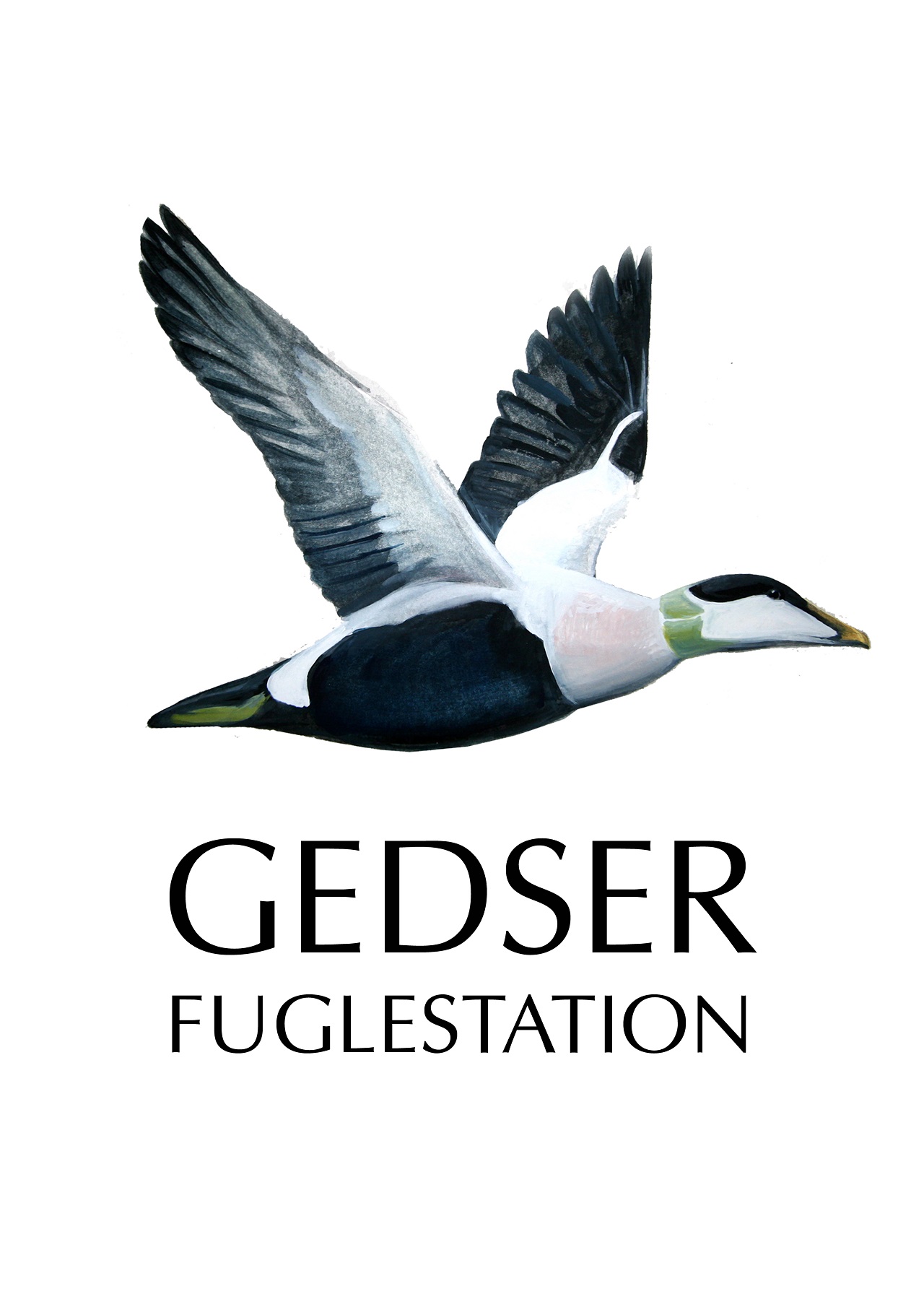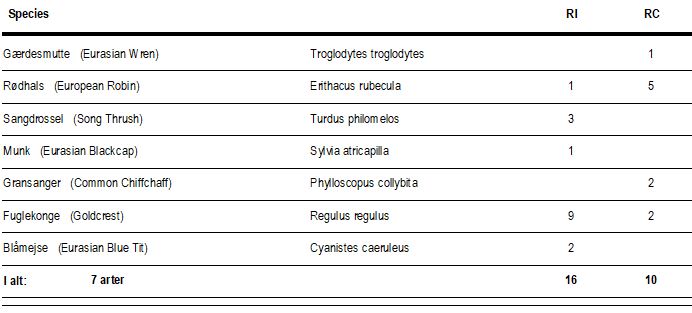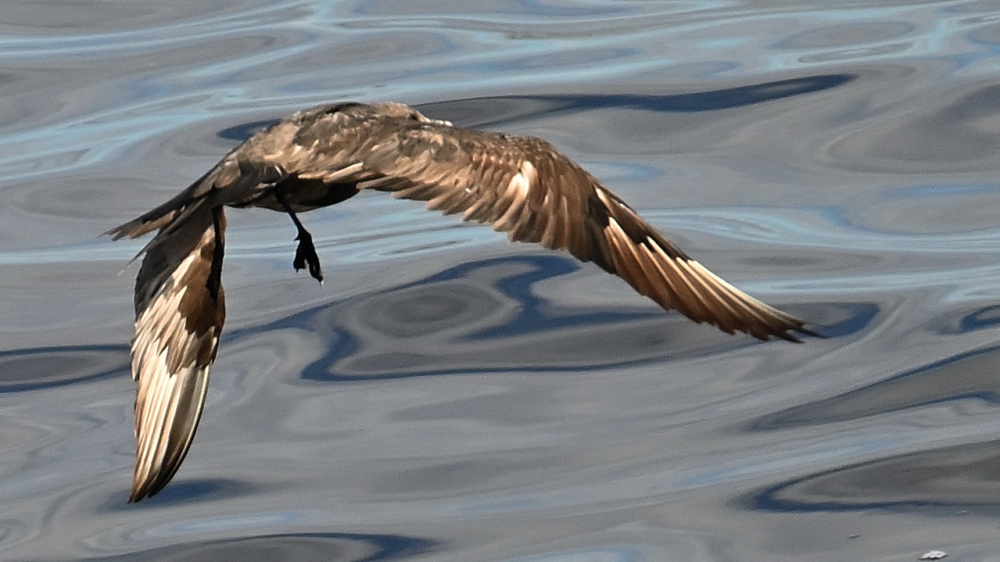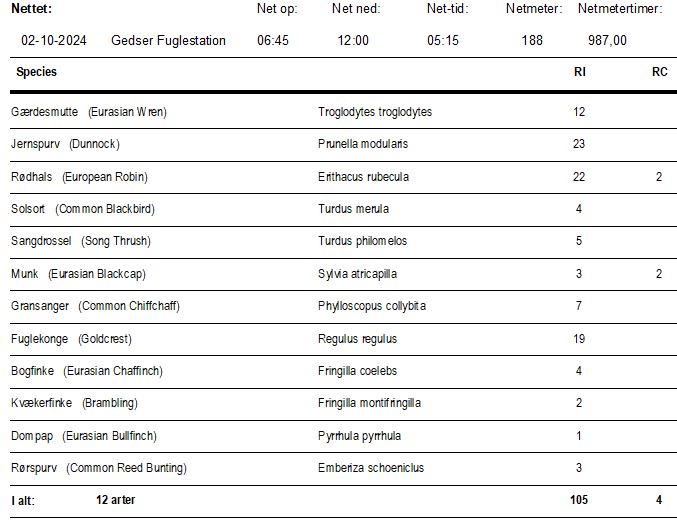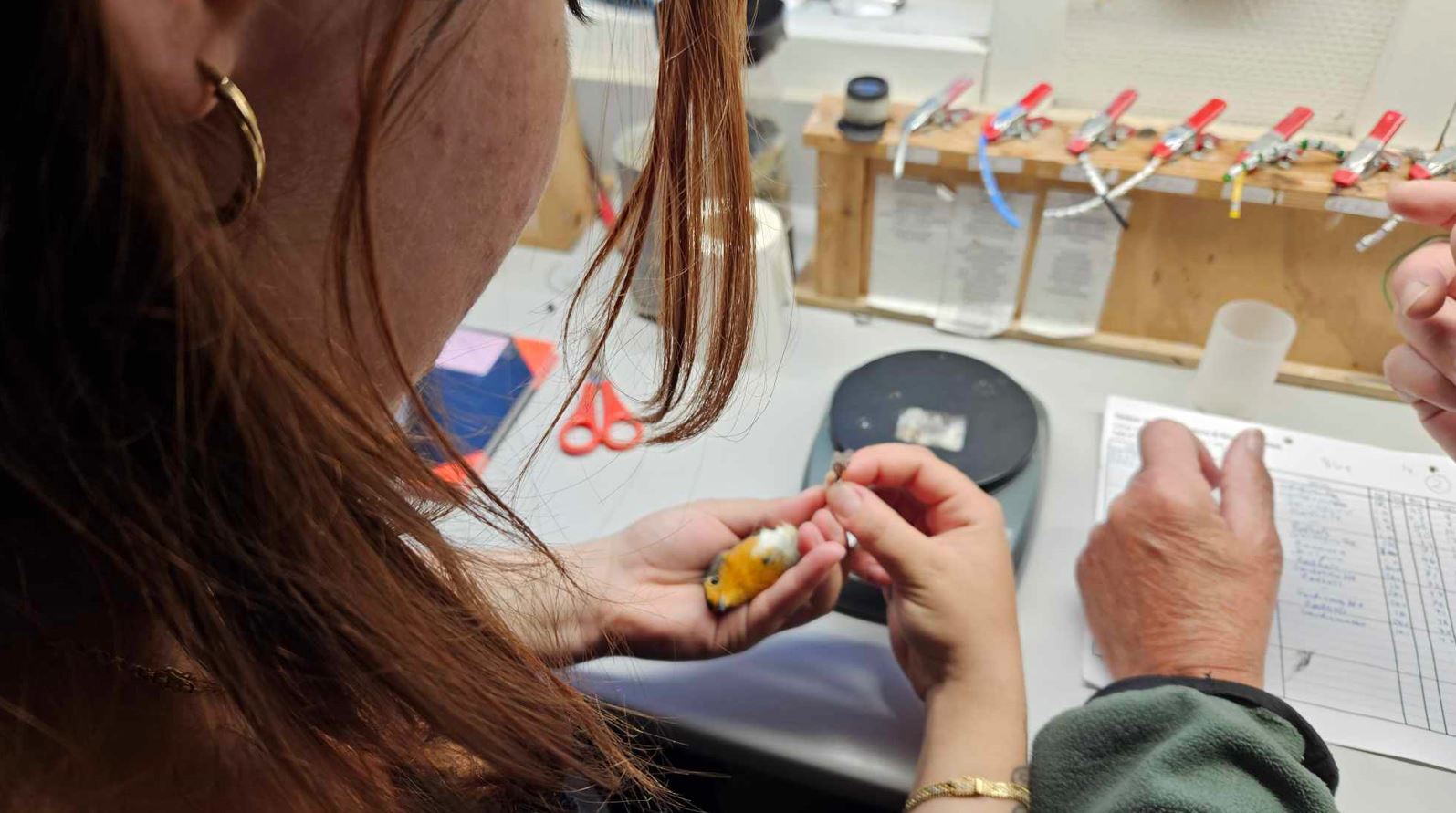Gedser Fuglestation Blog
Her på Gedser Fuglestations blog bringes korte nyheder i dagbogsformat om hændelser på fuglestationen.
To fine kurver og en langt under standard
Ringmærkningen: meget stille dag med ganske få fugle i haven, i luften sås en del grønsiskener. Regnvejr afsluttede fangsterne kl 11.

Trækket på Odden: Vi var tre tællere fra fuglestationen. Vinden var mindre kraftig end dagen før, men der kom mere regn – og lidt uventet: en del flere fugle, om end antallet ikke var imponerende med 2.435 fordelt på 31 arter. Den slags dage er alligevel rigtig gode til flere ting.
Først og fremmest er der mere tid til at diskutere, hvordan vi bestemmer de forskellige arter. Ofte kan vi ikke bruge ret meget fra bøgerne, når vi har dårlige lysforhold, og fuglene passerer hurtigt og på stor afstand. I stedet lærer vi af hinandens ’tommelfingerregler’ og af de diskussioner, vi nogle gange har tid til. Dernæst er den slags dage gode til at justere de skøn, som vi er nødt til at foretage, når vi ikke har tid til at tælle hvert enkelt individ på hastigt forbipasserende flokke eller meget store flokke. Vi træner med andre ord vores fornemmelse for, hvor meget 25 Ederfugle (Somateria mollissima) eller Pibeænder (Mareca penelope) fylder.
Ederfuglene og Pibeænderne hører til nøglearterne i fuglestationens træktællinger. Der kommer nemlig så mange af dem, at vi kan lave pålidelige statistikker med årlige sammenligninger og dermed bidrage til at belyse udviklingen for de arter i Østersøen.
 Efterårstrækket af Pibeænder ved Gedser Odde har det meste af efteråret ligget over gennemsnittet (mørke søjler) per time. Den røde streg viser det aktuelle træk, også per time. Grafik: Trektellen
Efterårstrækket af Pibeænder ved Gedser Odde har det meste af efteråret ligget over gennemsnittet (mørke søjler) per time. Den røde streg viser det aktuelle træk, også per time. Grafik: Trektellen

Trækket af Ederfugle har siden juni stort set fulgt gennemsnittet og oven i købet været lidt større i starten af oktober. Tallene er per time. De mørke søjler viser gennemsnittet over flere år. Den røde streg viser det aktuelle træk. Grafik: Trektellen.
Foreløbig ser dette efterårstræk fint ud for de to arter. Trækket af Pibeænder begyndte sidst i august, og vi kan forvente, at det fortsætter til midt i november, selv om det allerede har toppet. Vores tællinger viser, at trækket i starten af sæsonen lå lidt under normalen, men ellers mest har været over gennemsnittet ind i oktober.
Trækket af Ederfugle ser også fint ud indtil nu. Det har siden juni stort set fulgt gennemsnittet, men har i første del af oktober været over normalen. Derfor kan det blive ekstra interessant at følge frem mod den normale kulmination i anden halvdel af oktober, hvis trenden fortsætter. Vi indtaster både i den hollandske database Trektellen og på DOFbasen. Et udtræk af vores tal i Trektellen viser, at vi indtil nu har haft de tre største trækdage for Ederfugle ved Gedser Odde om efteråret 12. oktober 2013 med 28.560 fugle, 20. oktober 2022 med 33.498 og på toppen af statistikken over Ederfuglene 33.810 i løbet af seks timer 19. oktober 2021 på en dag, der også gav 4.599 Pibeænder.
 Trækket af Spurvehøge har indtil nu været en sørgelig forestilling, som den røde streg over det aktuelle træk per time viser ved mest at ligge langt under søjlerne med det gennemsnitlige træk over flere år. Grafik: Trektellen
Trækket af Spurvehøge har indtil nu været en sørgelig forestilling, som den røde streg over det aktuelle træk per time viser ved mest at ligge langt under søjlerne med det gennemsnitlige træk over flere år. Grafik: Trektellen
En tredje talrig art i efterårstrækket har det imidlertid stået ringe til med i år. Spurvehøgene (Accipiter nisus) plejer at være en talrig og spektakulær art i efterårstrækket, når de suser tæt og lavt forbi folk, der kommer for at opleve trækket af rovfugle. De første Spurvehøge kom som normalt midt i august, og i starten af september tegnede det til et fint træk med dagstal over gennemsnittet, men bortset fra den første uge af september har antallet af Spurvehøge været langt under standard. Vi forventer at se Spurvehøge langt ind i november, men der skal ske meget, hvis trækket ikke skal ende langt under gennemsnittet.
Se alle dagens observationer fra Gedser Odde i DOFbasen.
Folk på stationen: Freya-Mørup Petersen, Lara Winsloe, Larissa Britton, Lars Ulrich Rasmussen, Mads Elley, Ole Friis Larsen.
An October Morning
Ringmærkningen: Efter flere dage med vindstille vejr, blæste det atter op og der var lidt regn på radaren. Vi var i tvivl om det ville gøre det endnu bedre for antallet af fugle i nettene end de sidste par dage end det modsatte - det viste sig at blive det sidste.
Med 16 ringmærkede fugle og 10 genfangster, har det været en af de mere stille dage og vi lukkede net klokken 12. Der kom besøg på stationen og selvom der var få fugle, var der alligevel et par forskellige arter, som jeg fik vist frem - herunder Sangdrossel, Fuglekonge han og hun, Gærdesmutte og Blåmejse. Efter flere dage med mange Gransangere, var det også en overraskelse, at dagens antal af Gransangere lå på to genfangster. Men forhåbentlig kommer der lidt flere de næste par dage.
Trækket på Odden: Beautiful sunrise and cloud formations this morning, with pinks and lilacs painting the sky, as I walked up to Gedser Odde. Small numbers of lovely geese this morning, with Barnacle geese/Bramgås (Branta leucopsis), Dark-bellied Brent geese/Knortegås (Branta bernicla), and White-fronted geese/Blisgås (Anser albifrons) all gracing the skies. Also of note, a Common Guillemot/Lomvie (Uria aalge), eight Red-throated divers/Rødstrubet lom (Gavia stellata), and one Red-necked Grebe/Gråstrubet Lappedykker (Podiceps grisegena).
Now, excitingly, it is time for some gull highlights. I was very excited to see a Caspian Gull/Kaspisk måge (Larus cachinnans) this morning near the shore (not migrating), kindly shown to me by Ole. As we neared the last moments of the count, a number of Little Gulls/Dværgmåge (Larus minutus) flew past. It was a really calm and pleasant count today. As always, I am appreciative of the knowledge shared by those at the point alongside me.
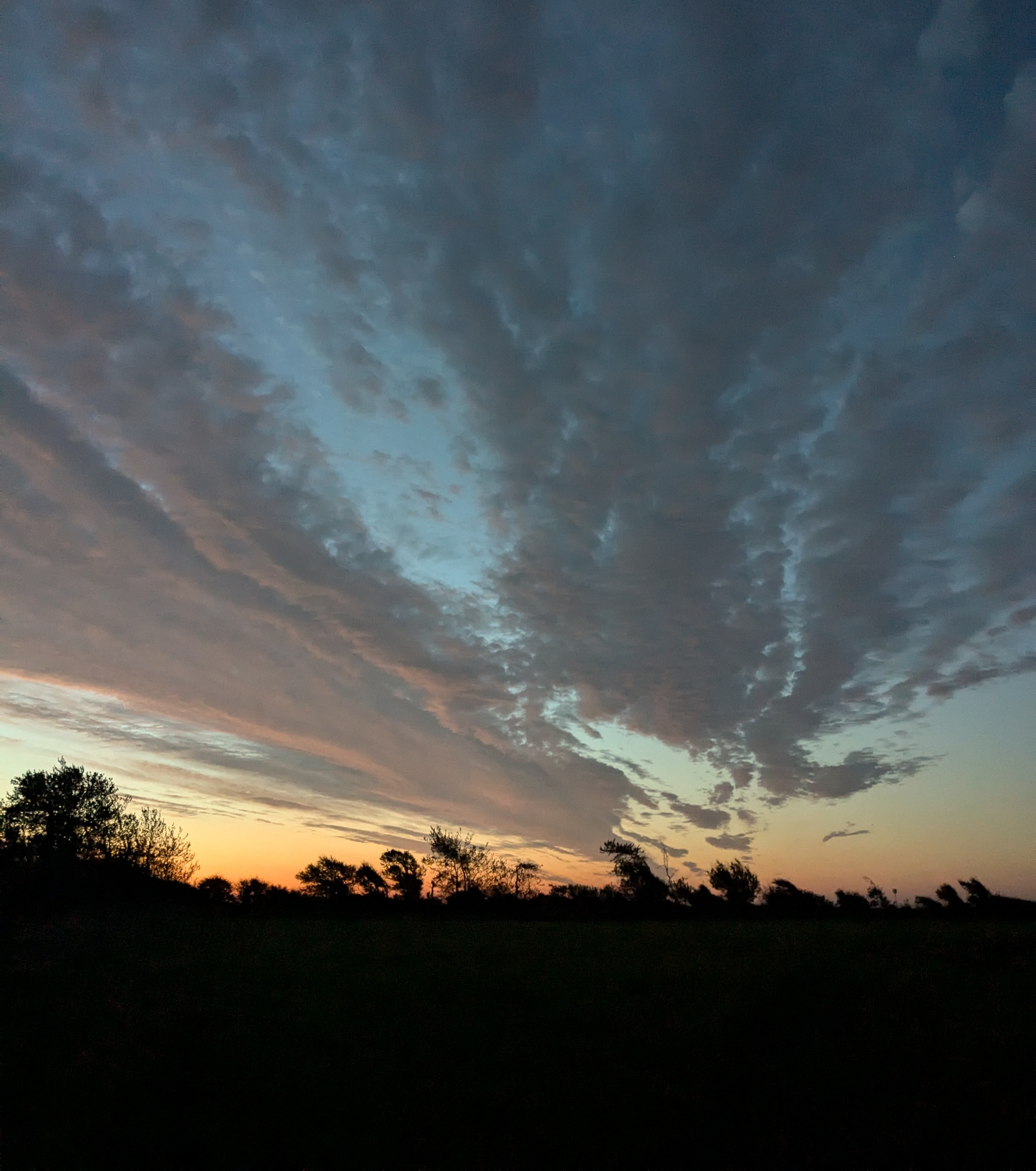
The sky at 06:40 this morning (foto: Larissa Britton)
Se alle dagens observationer fra Gedser Odde i DOFbasen.
Folk på stationen: Freya-Mørup Petersen, Lara Winsloe, Larissa Britton, Lars Ulrich Rasmussen, og Ole Friis Larsen
En dag med ternernes værste plageånd
Ringmærkningen: Endnu en dag med fint vejr: solskin, ingen vind og tørvejr.
Efter 2 fine dage med halvandet hundrede fugle forventede vi ikke det store, men det blev alligevel en god dag, med mange fugle fra morgenstunden, hvorefter det fandt et roligt leje.
Højdespringeren blev Gransanger/ Chiffchaff (Phylloscopus collybita) med næsten halvdelen af ringmærkningerne.
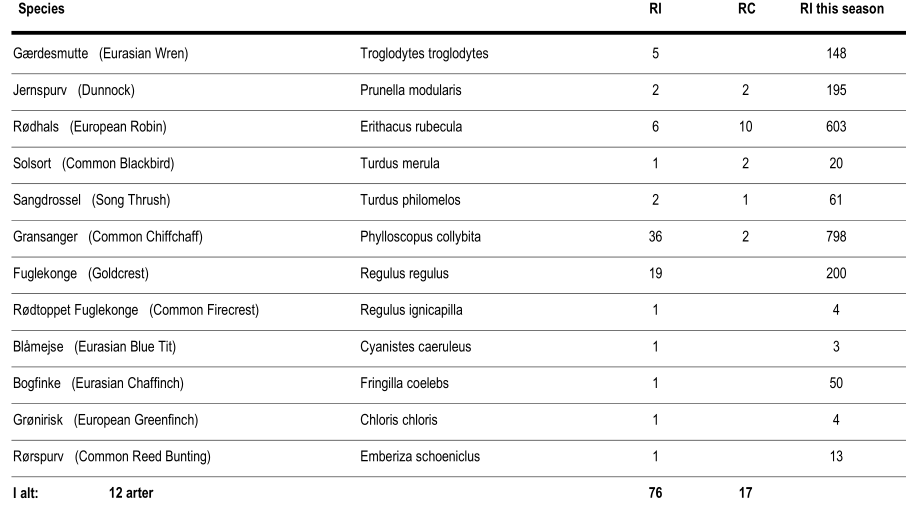
Trækket på Odden: En smuk og lun søndag med mange fuglefolk, oven i købet en tysk gruppe fra Berlin, som var på vej hjem fra en rundrejse i Sverige og havde lagt nogle timer ind i programmet til at se på træk ved Gedser Odde, før de skulle med færgen til Rostock. Fuglene var det derimod lidt småt med, men de fem standardtimer løb alligevel op i en ok oktoberdag med lidt over tusind fugle i timen på træk. Det blev til lige under 5.700 fugle fordelt på 46 arter.
Ederfuglene (Somateria mollissima) var der flest af med næsten 3.000 og dermed over halvdelen af dagens fugletræk, men der var også et fint træk af svømmeænder med over 1.100 Pibeænder (Mareca penelope) og et par hundrede Krikænder (Anas crecca) som de mest talrige.
Dagens bedste indslag var den Almindelige Kjove (Stercorarius parasiticus), der pludselig kom flyvende lige under os over de seneste dages tangopskyl, formet langs stranden af østenvindens bølger. Den landede og forsvandt for mange med en fjerdragt, der havde akkurat samme farve som den brune tangbræmme. Der ordnede den fjerdragten og holdt udkig efter Splitterner (Thallasseus sandvicensis) at overfalde for at stjæle deres mad. Når den satte af fra stranden, kunne vi høre den udsete terne skrige, længe før røveren nåede frem.
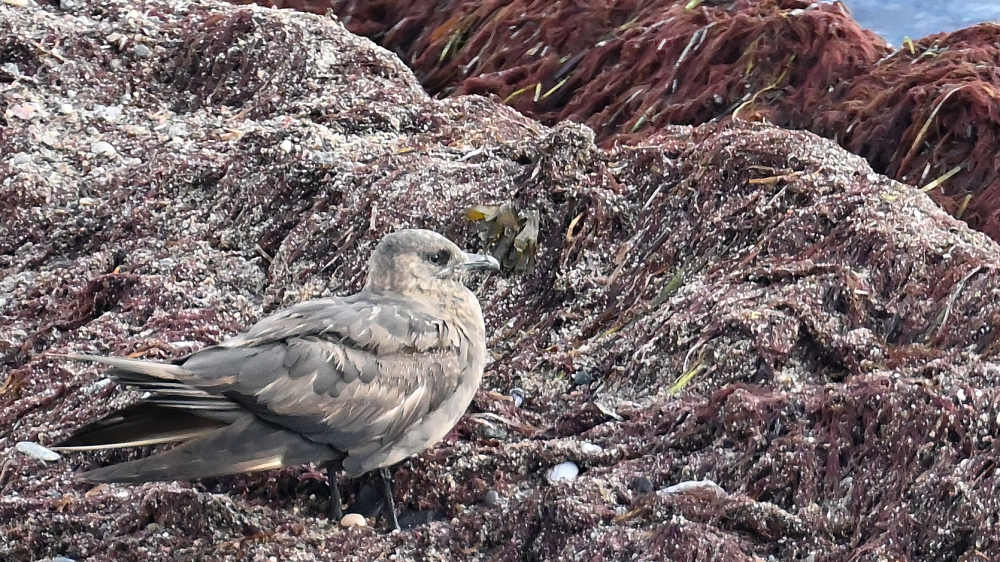
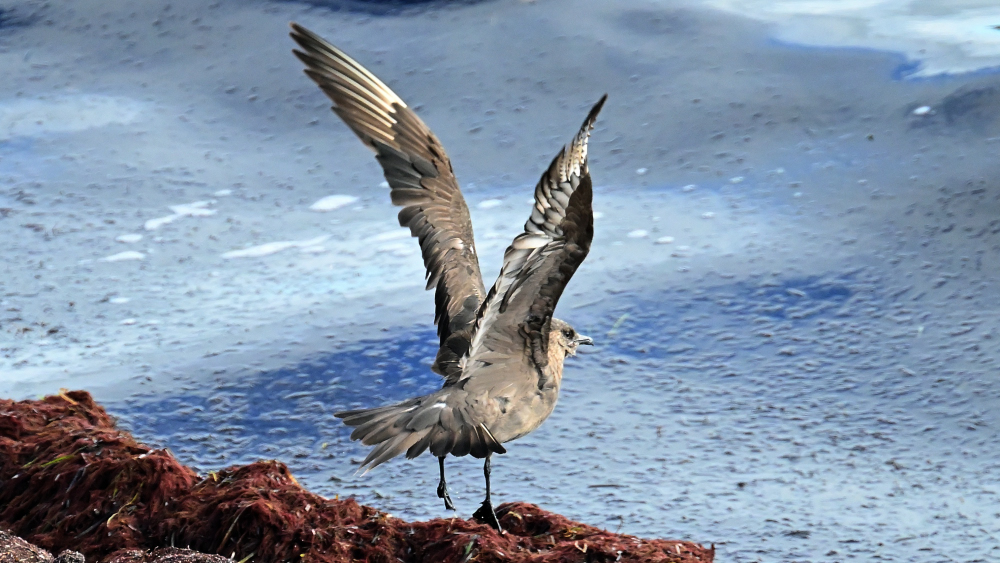
Vi er vant til kjover på træk ved Gedser Odde og til at se dem kaste sig over terner, der flyver med fisk i næbbet, men det hører til de sjældne oplevelser, at kjover holder til ved stranden i timevis eller en hel dag, som denne kjove gjorde. Måske var den ikke helt rask, eller den var gammel. Vi havde en fornemmelse af, at den ikke var helt frisk, og at det var derfor, den holdt til på stranden, men den foretog adskillige udfald mod ternerne, så det kan også være, at den bare syntes, at det var et fint område til en pause i trækket. Almindelige Kjover yngler langt mod nord kloden rundt og flyver til kystområder ved Sydamerika, Sydafrika, Australien og New Zealand for at overvintre. Kjoven ved Gedser Odde var derfor højst sandsynligt på vej fra Nordkysten af Norge eller Rusland mod Sydafrika.
Se alle dagens observationer fra Gedser Odde i DOFbasen.
Folk på stationen: Freya-Mørup Petersen, Lara Winsloe, Larissa Britton, Lars Ulrich Rasmussen, Mads Elley, Ole Friis Larsen og Vagn Lind (der havde sidste arbejdsdag som ringmærker i denne omgang).
EuroBird Watch 2024!
Ringmærkningen: Efter styregruppen gjorde klar i går, var stationen klar til Åbent Hus i dag og vi håbede på en masse fugle, som vi kunne vise frem til gæsterne. Det var vindstille og næsten skyfrit fra morgenstunden, hvilket både kunne være godt og skidt for ringmærkningen. Med stille vejr, er der ofte flere fugle, men vejret kan også være 'for godt' hvor alle småfugle trækker næsten med det samme og ikke går ned i haven. Vejrudsigt og success for ringmærkning kan være umuligt at forudsige, så jeg vidste ikke, hvad jeg kunne forvente af dagen.
Vi fik hurtigt travlt på første runde, da et af de første net var fyldt med Gransangere og jeg løb op til labbet for at hente kasser, imens Lars Ulrich begyndte at pille. Den første runde havde snildt 30 Gransangere, som alle fik en ring på og dagstotalen blev 55.
Da klokken blev ni, begyndte der at komme folk til og da jeg havde meldt mig som formidler til de besøgende gæster, flyttede jeg udstyr, mapper og tre forskellige ringserier ud på et lille bord foran huset, så de besøgende kunne se ringmærkning. En af de første fugle, som blev fanget ved Åbent Hus, var endnu en Stor Flagspætte, som fik ring på i labbet og derefter blev vist frem til mange gæsters store glæde. Den fik også sat nogle hak i min hånd, inden den fløj videre.
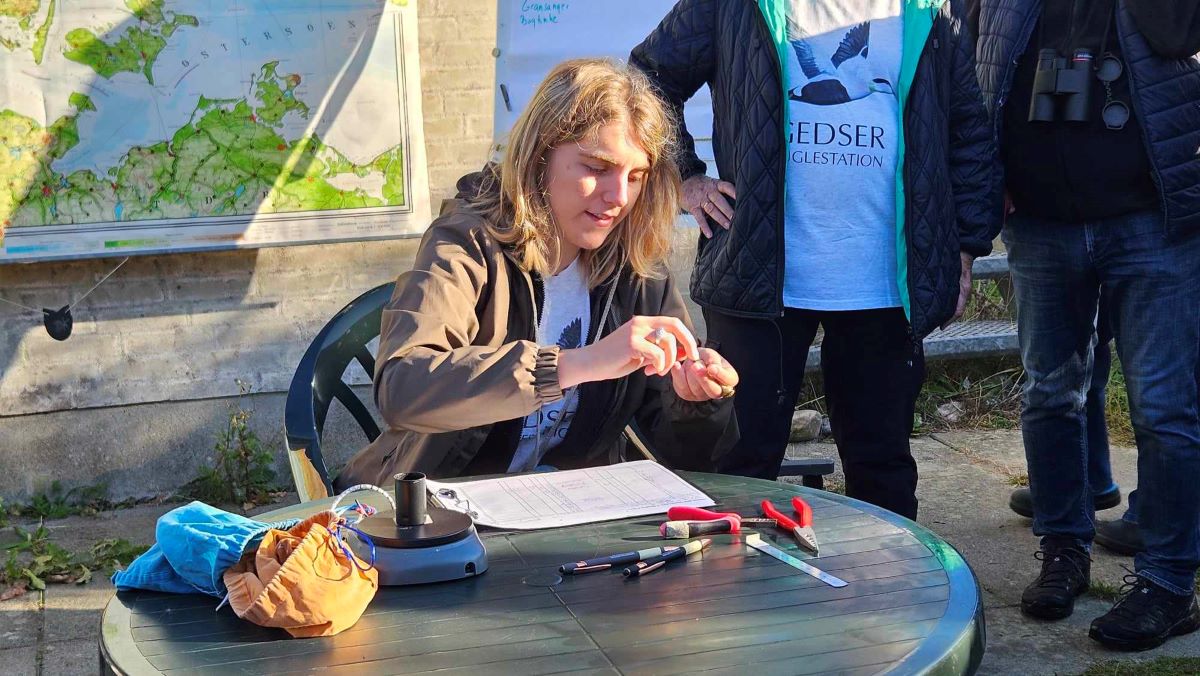 Den mobile ringmærkningstation foran stationen. Her får en af dagens mange Gransangere en ring på. Foto: Mads Elley
Den mobile ringmærkningstation foran stationen. Her får en af dagens mange Gransangere en ring på. Foto: Mads Elley
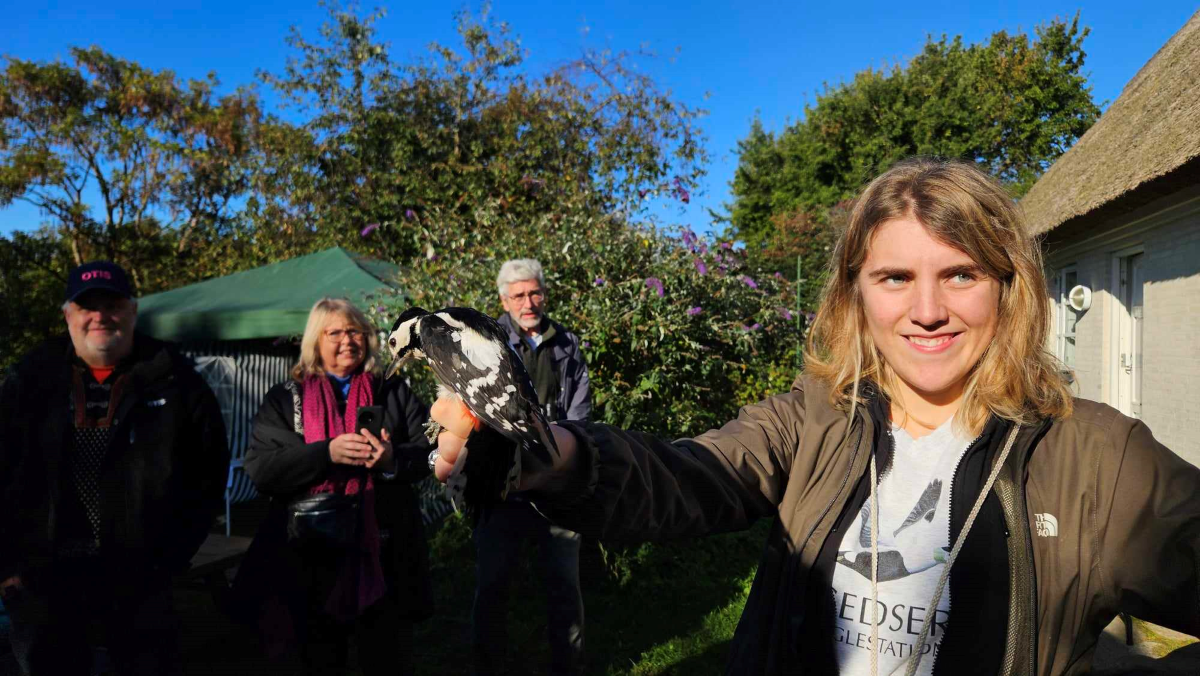 Stor Flagspætte 1k hun bliver fremvist til stationens gæster. Foto: Mads Elley
Stor Flagspætte 1k hun bliver fremvist til stationens gæster. Foto: Mads Elley
Derudover fik de besøgende set Fuglekonger, Gransangere, Rødhalse, Gærdesmutter, Jernspurv og Munk i hånden og med jævne mellemrundt viste Tina og Mads Elley grupper af besøgende rundt i haven. Da klokken var 12, gik de sidste gæster og personalet fik sig en velfortjent frokost i et vindstille vejr med sol fra en skyfri himmel, som næsten virkede sommerligt. Et absolut vellykket Åbent Hus på Gedser Fuglestation og en ære for mig at kunne formidle for de mange besøgende!
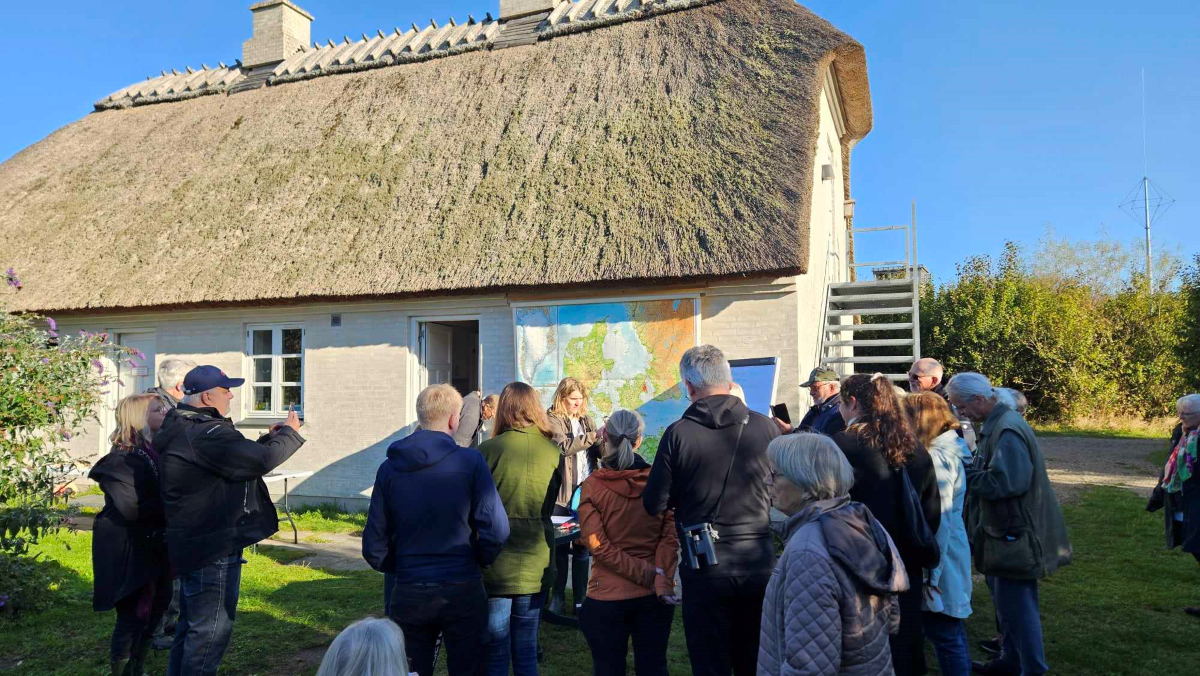 Der kom mange gæster! Foto: Mads Elley
Der kom mange gæster! Foto: Mads Elley
Migration at Odden:
by Lara W
I somehow whiled away an entire day, from sunrise to sunset, at Gedser Odde birdwatching today. The slight breeze in the morning gave way to an almost glacial calm by the afternoon. I have never seen the sea so still here, the birds flying, so close to the water to almost touch, almost perfectly reflected in the mirrored surface. Although the point was busy with visitors up until midday, many of whom had come to visit as part of our planned Euro Birdwatch event, by mid-afternoon the only sounds to be heard were the rushing whistles of wings from the geese/gæs flying above, the occasional raucous screeching of the terns and gulls, and the peeping calls from various passing passerines.
During our standard count time this morning, 6393 individuals of 51 species were counted passing the point. The most numerous of these were the Common Eider/Ederfugl (Somateria mollissima), at 3863 birds, followed by 609 Wigeon/Pibeand (Anas Penelope) and 568 Barnacle geese/Bramgås (Branta leucopsis). Raptor numbers were noticeably low, although we had a fair few species coming over the fields, including a Peregrine falcon/Vandrefalk (Falco peregrinus), 5 Rough-legged buzzard/Fjeldvåge (Buteo lagopus), a Black Kite/Sort Glente (Milvus migrans) and a Hen Harrier/Blå Kærhøg (Circus cyaneus). The arrival of the peregrine was announced by a preceding flock of around 100 Common gull/Stormmåge (Larus canus), all of which surged upwards from the fields outside Gedser to wheel, screaming, about the harbour. Later on in the afternoon, a couple of White-tailed eagle/Havørn (Haliaeetus albicilla) and several Common buzzard/Musvåge (Buteo buteo) were spotted circling slowly, high up in the clouds inland.
We were lucky enough to have a great many Little gull/Dværgmåge (Hydrocoloeus minutus) passing us, usually in small flocks of 4-6 but sometimes more – amounting to 91 birds in all. Also, 54 Common gull, and 13 Black-headed gull/Hættemåge (Chroicocephalus ridibundus). Additionally, we counted a fair few passerines, which headed both north and south, most likely influenced by the low North-easterly winds. These included 77 White wagtail/Hvid Vipstjert (Motacilla alba) going south, with 41 heading north; 34 Meadow pipit/Engpiber (Anthus pratensis) south and 16 north; and 173 Linnet/Tornirisk (Linaria cannabina) south with 11 flying north. Interestingly, a couple of Serin/Gulirisk (Serinus serinus) were heard passing the point later on in the afternoon.
The highlight of the day occurred in the final few minutes, just as we were packing up our bags to go. A skua (which we believe to be an Arctic skua/Almindelig Kjove (Stercorarius parasiticus), but pending proper examination of the photos) came roaring after a Sandwich tern/Splitterne (Thalasseus sandvicensis), which proceeded to screech its way across the sky, trying desperately to keep ahold of his fish! A furious bird-chase ensued, from which the skua emerged triumphant. A fabulous end to a beautiful day.
EuroBird Watch: Gedser Fuglestation havde mindst 110 gæster til EuroBird Watch lørdag formiddag fra klokken 9 til 12. EuroBird Watch er en årlig begivenhed i BirdLife Europa, som DOF/BirdLife Danmark er med i. Hver organisation laver sine arrangementer, men ideen er, at der bliver sat fokus på fugletrækket med arrangementer for publikum overalt i Europa. I Danmark foregår det med åbent hus på de tre fuglestationer i Skagen, Blåvand og Gedser, som netop er de steder, hvor der bliver arbejdet mest med trækfugle i DOF.
På Gedser Odde kom de fleste til selve fuglestationen for at opleve ringmærkning, men der var også nogle, som fandt vej til arrangementets anden del, der foregik ude på Gedser Odde, hvor den daglige tælling af efterårstrækket foregår. Her tog vi imod med kaffe, kage og teleskoper til fri afbenyttelse.
Dagens fem timer lange standardtælling fra en halv time før solopgang gav 6.393 fugle. Mange af fuglene i havtrækket har fløjet tusindvis af kilometer fra det nordligste Sibirien, før de runder Gedser Odde. De mest talrige arter var 3.863 Ederfugle, 609 Pibeænder og 568 Bramgæs, som først er begyndt at vise sig i de seneste dage.
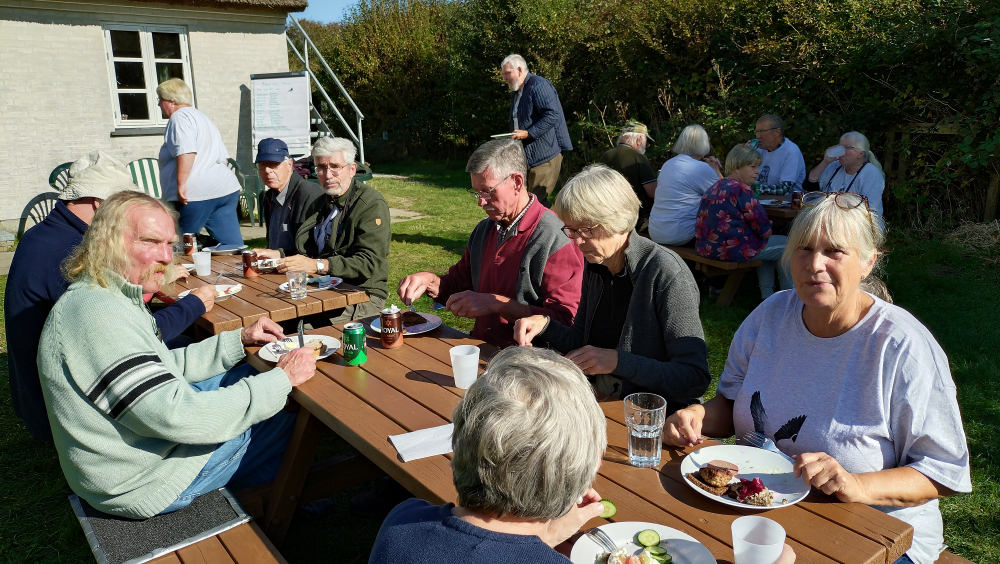
Fra land kom der en håndfuld rovfugle. Alle nød det flotte og lune efterårsvejr med næsten ingen vind, men fik ikke det rovfugletræk, de var kommet for. Underholdningen stod tre helt almindelige Husskader for. De holdt til i toppen af nøjagtig det samme træ, som en Nøddekrige i september brugte som afsæt til talrige daglige trækforsøg, der alle endte med, at den gav op og vendte om på kanten af kysten. Akkurat sådan er det også foregået for dens afløsere, Husskaderne, det seneste par oktoberdage.
Folk på stationen: Vibeke Holst Jensen, Kristian Kokholm, Ester Dalby Andersen, Tina Elley, Mads Elley, Bente Wagner Michelsen, Anne Marie Reith, Ulla Kayser, Ann Katrin Reith, Ole Skytte, Lars Ulrich Rasmussen, John Hartwich, Gert Juul Jeppesen, Per Sander, Bente Hartwich, Bo Kayser, Jan C. van Dijk, Anni Rose Skytte, Poul Henrichsen, Freya Mørup-Petersen, Lara Winsloe, Larissa Britton, Vagn Lind, Ole Friis Larsen
Birds and birds, and birds and birds
Ringmærkningen: October ringing continues at a steady pace. Officially, I held my first recapture Blåmejse/Blue Tit (Cyanistes caeruleus) today and, boy, do they give quite a strong pinch with their beak! Nevertheless, a very pretty bird. In the Blue Tit’s company, a Træløber/Treecreeper (Certhia familiaris) and a Spurvehøg/Sparrowhawk (Accipiter nisus), and were both caught and ringed today, to then be released into the golden Autumn sunshine.
Additionally we had a a Stor flagspætte/Great Spotted Woodpecker (Picoides major). This individual was quite loud as we removed it from the mist net, but then sat very well (and peacefully) in-hand. The first Stor flagspætte was ringed in Denmark in 1917 (according to The Danish Bird Migration Atlas).
I have not put any moth traps out, but I did spot a beautiful Angle Shades (Phlogophora meticulosa) moth basking in the sunlight, on the window. The caterpillars of this moth like to feed on Common Nettle (Urtica dioica), of which we have an abundance of around the station.
We will see what tomorrow brings, and who flies into our nets.
 Stor flagspætte 1K Han (foto: Larissa Britton)
Stor flagspætte 1K Han (foto: Larissa Britton)
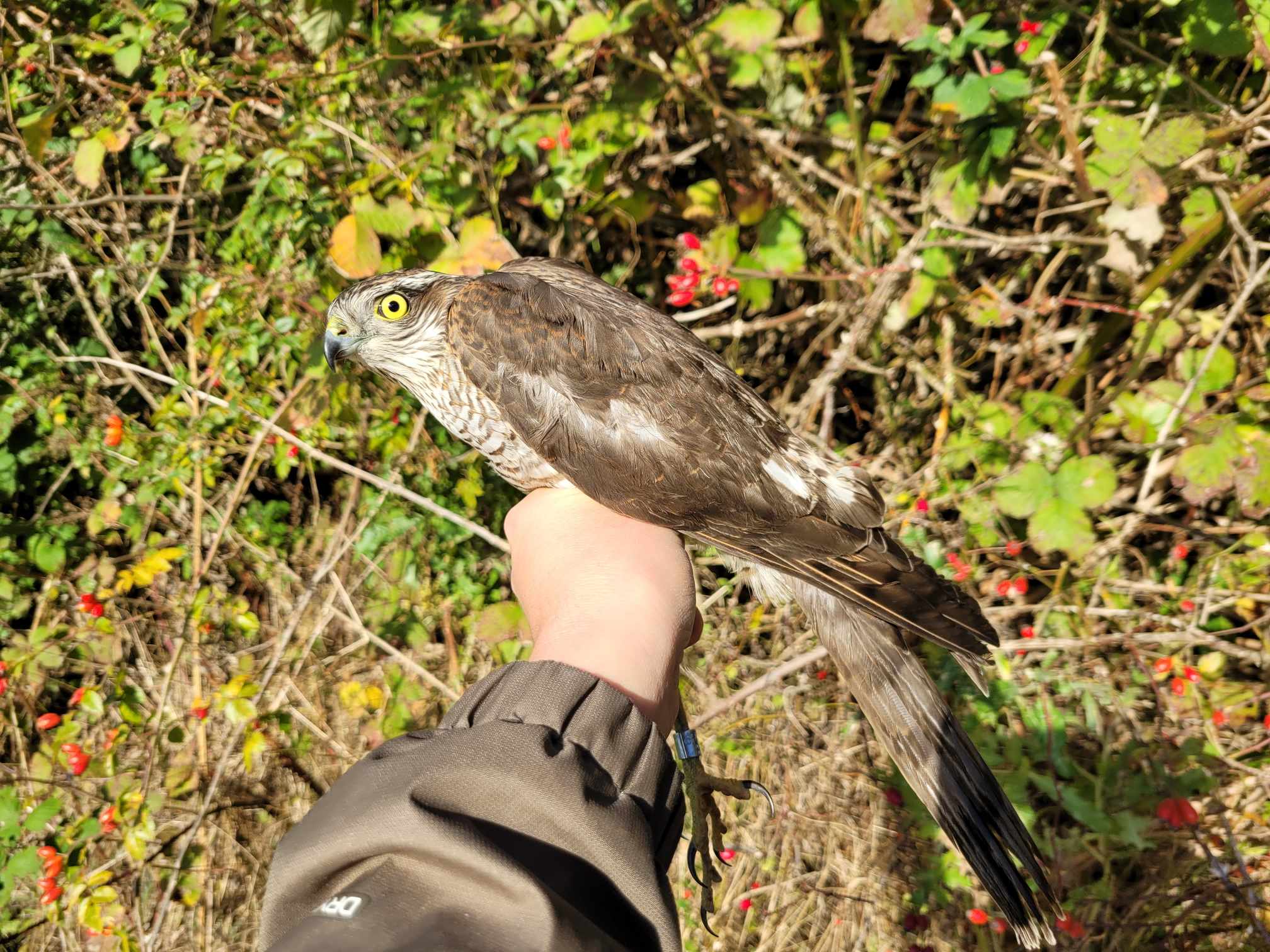 Spurvehøg (foto: Freya Mørup-Petersen)
Spurvehøg (foto: Freya Mørup-Petersen)
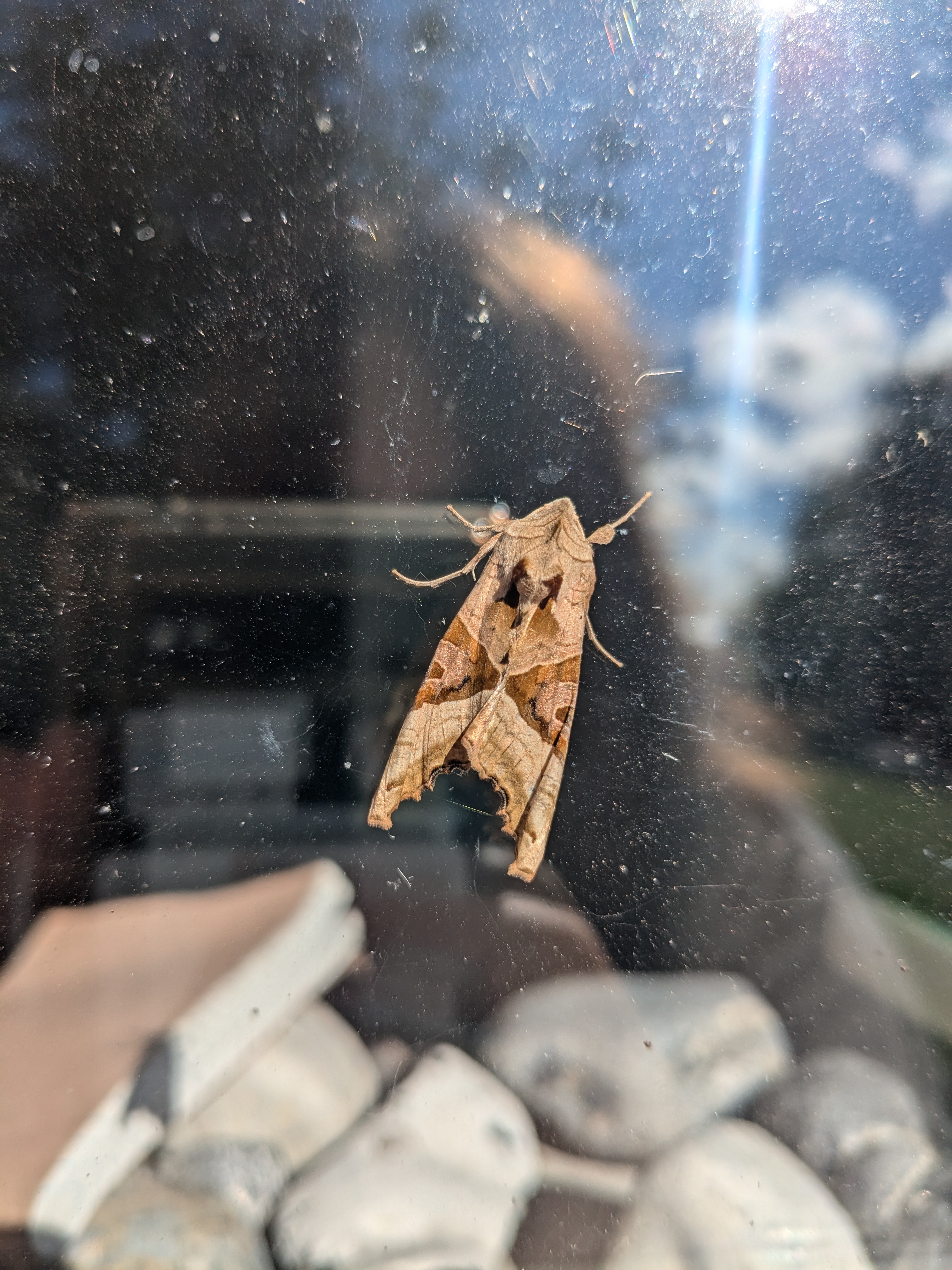 Phlogophora meticulosa (foto: Larissa Britton)
Phlogophora meticulosa (foto: Larissa Britton)

by Lara W
One of the most wonderful things about a prolonged stay at Gedser is witnessing the changes in migration. When I first arrived about a month ago, roughly a thousand birds passed the point during our standard counting time (a period of five hours starting from half an hour before sunrise). Looking back, it was a perfect time to begin learning how to identify and count various species, as numbers were manageable, permitting time for discussion and identification tips to be passed along. In the past couple of weeks, the number of birds passing the point have increased dramatically, and we are now regularly seeing 5000+ birds within the standard time frame. Numbers have actually passed the 10k mark on a few days, and it looks set to continue at an exponential rate. What is fascinating, is that no two days are the same. Some days, passerine species dominate, others, raptors, and some days the seaducks take precedent. For those who have not experienced it, the feeling is like no other; a paradoxical mix of thrilling excitement, and peaceful contentment. Like a feather brushed along the spine.
Today, a total of 8943 individuals representing 33 species were counted migrating, along with several new species for the season spotted foraging around the point. As I stated above, the changes are evident in the numbers: this past week, various geese/gæs and Columbidae species are beginning to dominate, with four different geese spotted today: 900 Dark-bellied Brent goose/ Knortegås (Branta bernicla), 10 Greylag goose/Grågås (Anser anser), 14 Tundra bean goose/Sædgås (Anser fabalis rossicus), and 249 Barnacle/Bramgås (Branta leucopsis). Later this afternoon, three flocks of Barnacles, equalling around 80 birds flew over my head out in the meadow beyond the station within the space of half an hour, so I imagine that small flocks may well have continued passing south throughout the day. 450 Woodpigeon/Ringdue (Columba palumbus) and 28 Stock Dove/Huldue (Columba oenas), also passed over, their gigantic flocks reminiscent of Hitchcock’s The Birds (1963), although thankfully without the malevolent undertones. I was struck, as before on the “Crane/Trane Day”, by the reality of several hundred birds passing by so close. It is not a feeling easily described, and gives one a feeling of connectedness to the natural world not often felt. We are all just trying to find our way, afterall.
The really big numbers came from the Common Eider/Ederfugl (Somateria mollissima), starting from the second I arrived (rather breathless) at the point – 6142 individuals, which again consisted almost exclusively of male birds. These came in flocks ranging in size from 3 to 80, although groups of around 30 were the most common, with the occasional Wigeon/Pibeand (Anas Penelope) or Teal/Krikand (Anas crecca) thrown in for the sake of diversity. Red-breasted Merganser/ Toppet Skallesluger (Mergus serrator) numbers are on the rise, with 99 passing the point today, along with divers of both the red -and black-throated variety flying either solitarily or in pairs (a total of 11 Red-throated Diver/Rødstrubet Lom (Gavia stellata) and 2 Black-throated Diver/Sortstrubet Lom (Gavia arctica)). 3 Red-necked Grebe/Gråstrubet Lappedykker (Podiceps grisegena) also flew by much to our pleasure! Passerines were also present, although only a few actually migrated – including 26 Siskin/Grønsisken (Spinus spinus) and 82 Swallow/Landsvale (Hirundo rustica) – however quite a few others formed flocks around the point but did not seem ready to leave yet, including Greenfinch/Grønirisk (Chloris chloris), and several large groups of Siskin and Chaffinch/Bogfinke (Fringilla coelebs). Perhaps they will depart over the weekend. I refuse to make more than a passing mention of the two Magpie/Husskade (Pica pica) floating around making half-hearted passes at the point.
Three species drew our attention in particular. Two Caspian gull/Kaspisk Måge (Larus cachinnans) were seen amongst a group of gulls foraging, identifiable by their snowy-white heads in contrast to the mottled appearance of the usual Common gull/Stormmåge (Larus canus) and Herring gull/Sølvmåge (Larus argenteus). Three Purple sandpiper/Sortgrå Ryle (Calidris maritima) were witnessed happily feeding along with some sanderlings along the new surge of sand formed south of the point by the recent changes in wind direction. In addition, two Great grey shrike/Stor Tornskade (Lanius excubitor) were seen flitting about the point, and although I did attempt to photograph them, they were altogether too skittish to capture. Hopefully they will appear again tomorrow. Being not a common bird at all in my homeland of the UK, these were lovely birds to see. The long whiskers on either side of the bill, similar to those present on nightjar/natravn (although not nearly so long), betray the birds’ reliance on this sensory organ for prey-catching.
Tomorrow is Euro Birdwatch! We at the station will be hosting visitors coming to observe our ringing and migration counting activities, please do come along to see what we do!
N.B. In relation to Larissa's comment above on Blue tit/Blåmejse: they are the cutest, sassiest birds to ring, and anyone who says otherwise is just plain wrong.
People at the observatory: Vagn Lind, Lara Winsloe, Larissa Britton, Freya Mørup-Petersen, Lars Ulrich Rasmussen, Mads Elley, Ole Friis Larsen
Et rigtigt møgfald
Ringmærkningen: Dagen startede ud med let vind fra nord. Vi var fire ringmærkere, så vi håbede på en god dag med masser af fugle. Første runde var relativt stille, med 10-15 fugle, herunder en Sangdrossel i øverste netlomme, som klattede mig i ansigtet - heldigvis havde jeg munden lukket!
Ved anden runde tog tingene en drejning, da der lige pludselig var så mange fugle, at jeg løb tør for poser, på trods af jeg havde mange med og jeg måtte løbe tilbage til labbet for at hente flere poser og kasser. Det var tydeligt at der havde været et mindre småfuglefald om natten. Igen var der en del drosler i dag og flere af dem fik også klattet på mig.
Efter klokken 9 blev tingene mere roligt, men vi forsatte med at ringmærke efter standard og lukkede først, da vi blev trætte 15.45, hvor vi havde 5-10 fugle per runde. Dagen bød mest på Jernspurve og Gransangere, men værd at nævne var en Rødtoppet Fuglekonge og sæsonens første Grønsiskener og Vindrossel. Billeder blev der ikke mange af grundet den travle standard, men som jeg sidder her og skriver dette må jeg sige, at jeg er godt træt og godt tilfreds.
Trækket på Odden: Nu kommer gæssene. Torsdagens træk ud af Østersøen var både interessant og underholdende. Vinden var slået om i nord til forskel fra de foregående dages østprægede blæst, og vi fik ikke havtrækket så tæt på, men den kolde luft var klar, og det var let at se langt ud over havet. Vi fik de første signaler om gåsetrækket med et par Blisgæs (Anser albifrons), en lille flok Tundragæs (Anser serrirostris) i kølvandet på den første fugl af arten onsdag, og så kom der Bramgæs (Branta leucopsis). Dagens 350 Bramgæs fløj lidt i forskellige retninger, men vi kan roligt kalde dem et første varsel om et stort træk på vej. Kollegerne på den estiske træklokalitet Põõsaspea neem observerede 800 km fra Gedser Odde et bemærkelsesværdigt stort ryk af 13.500 Bramgæs. Det er russiske ynglefugle på vej væk fra Sibirien for at overvintre i Nordvesteuropa.
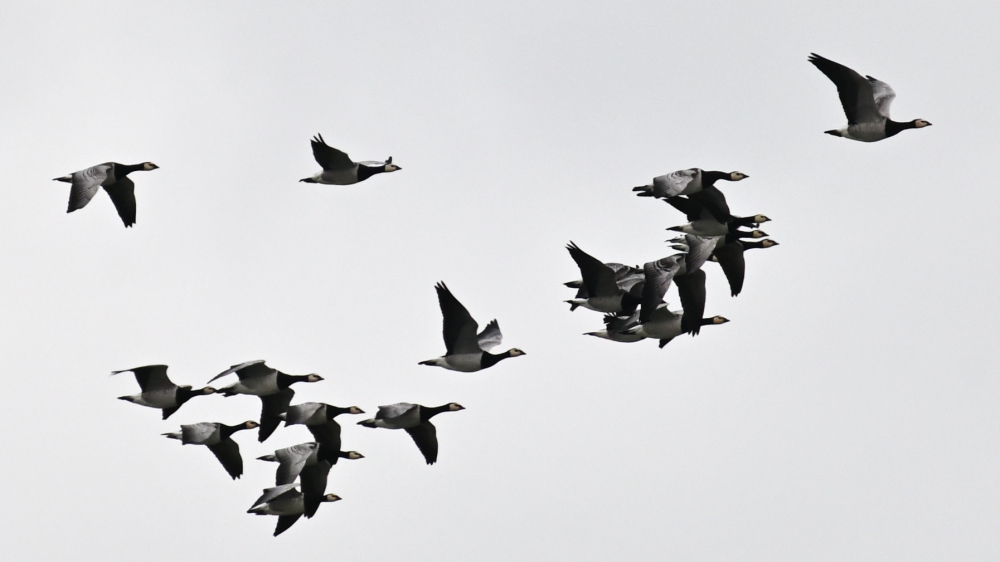
Ellers var torsdag morgen præget af Ederfugle (Somateria mollissima) med dette efterårs hidtil største antal på 7.800 fugle som dagens suverænt dominerende art. Langt de fleste var hanner. Det hedder sig, at det er et stigende antal Havørne (Haliaeetus albicilla), der er skyld i, at hunnerne og deres unger falder kraftigt i antal, men så galt er det næppe med Havørnene. På en konference i om Havørne i Osijek i Kroatien i september fortalte en forsker fra universitetet i Turku om undersøgelser, der viser, at Ederfuglene er begyndt at søge væk fra de yderste øer uden træer og buske i den finske skærgård for i stedet at yngle mere skjult under buske og træer på de indre øer og inde på fastlandskysten, hvor Havørnene måske er med til at stresse andre rovdyr og på den måde måske ligefrem er med til at beskytte Ederfuglene. Så er der nogle ’bander’ af unge Havørne, som kan rydde hele øer i skærgården for Ederfuglenes æg og unger, men, som forskeren sagde: ”Vi har over 100.000 øer i skærgården, og nogle flokke af immature (unge) Havørne kan altså ikke overkomme at plyndre alle øerne”.
Den store og overraskende variation, der kan være i trækket ved Gedser Odde kom torsdag til udtryk ved, at vi kun så 6 Traner (Grus grus) dagen efter, at vi havde det hidtil tredjestørste dagsantal på lokaliteten med 3.660 fugle – hvilket ganske givet skyldtes, at den hårde østenvind pressede ekstra mange Traner, der ellers ville være fløjet direkte fra Sverige til Rügen i Tyskland, ind over Sjælland, Lolland og Falster. Markant anderledes var det også med kun 3 Røde Glenter (Milvus milvus) efter det rekordstore antal på 162 for Odden onsdag formiddag.
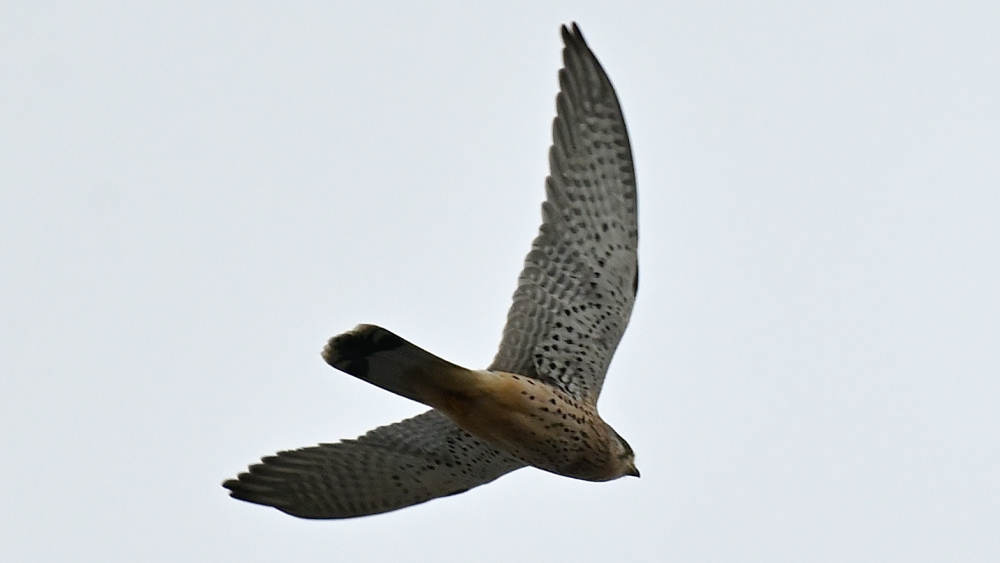
I alt blev det til 9.905 fugle af 41 arter.
Se alle torsdagens observationer fra Gedser Odde i DOFbasen.
People at the observatory: Vagn Lind, Lara Winsloe, Larissa Britton, Freya Mørup-Petersen, Lars Ulrich Rasmussen, Mads Elley, Ole Friis Larsen
Kvæk og Pap
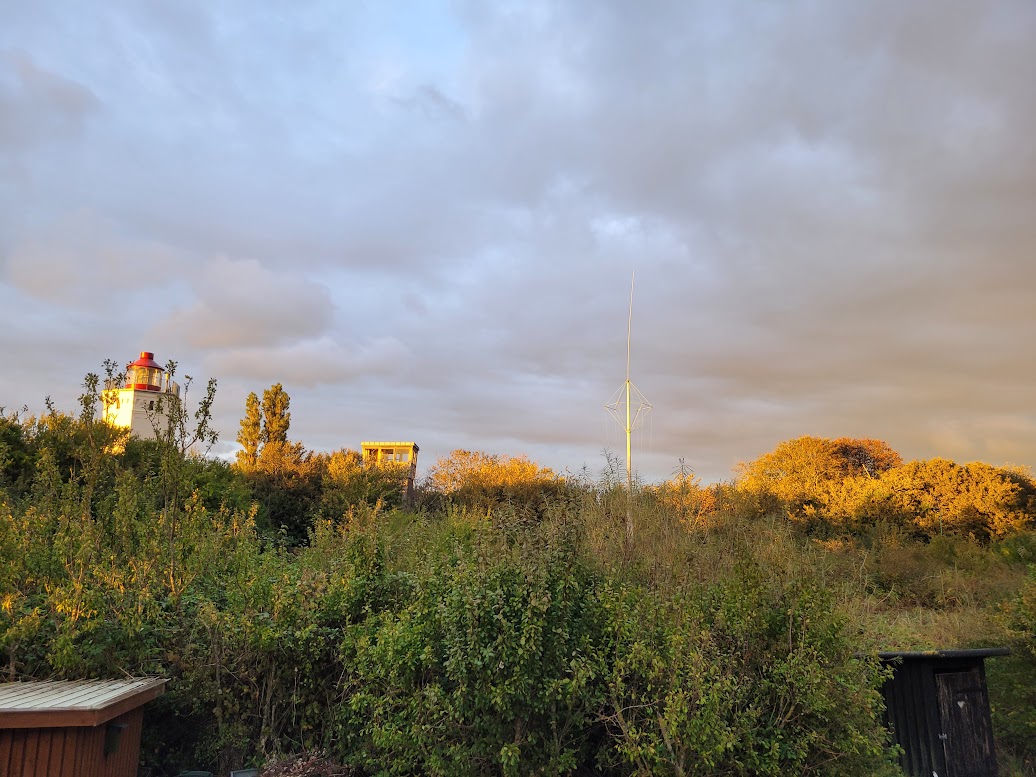
Aftenstemning
Ringmærkningen: Endnu en morgen med friske vinde som desværre igen betød, at vi måtte undvære alle nettene der vender ud mod den østlige side af Odden. Heldigvis har temperaturfald og den kraftige omrøring i luftmasserne over DK de seneste dage sat gang i et betydeligt træk ned over Falster.
Luften gav genlyd af traner, finker og drosler mm fra morgenstunden, og i stationshaven dukkede bl.a. 4 Solsorte op, - en fugl jeg ikke har set skyggen af siden jeg kom for over en uge siden.
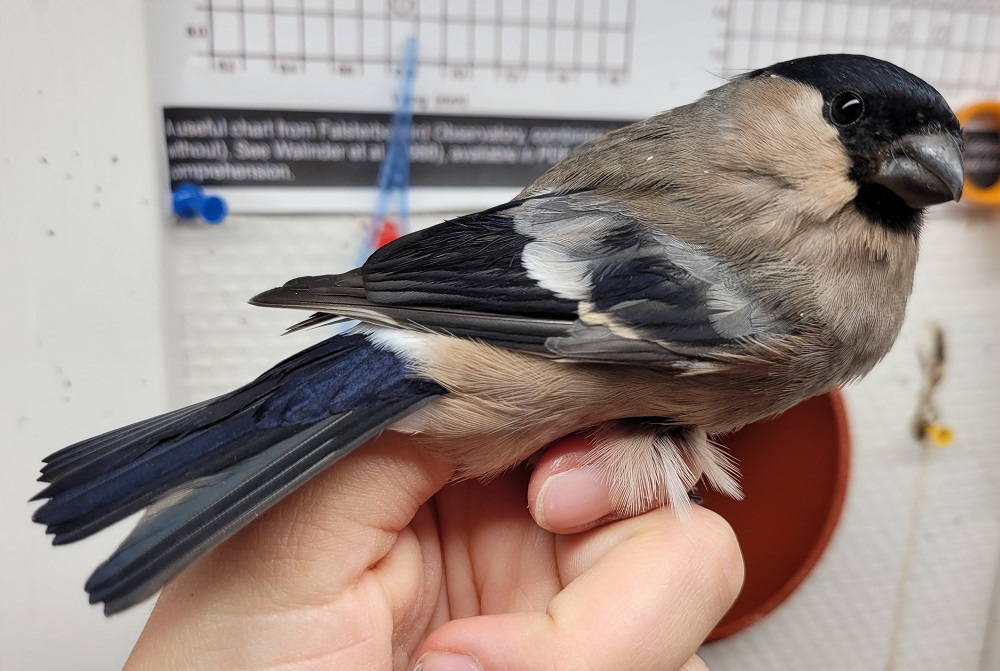 Dompap
Dompap
Jernspurv, Rødhals og Fuglekonge blev topscorere, men især glædede vi os over det pæne antal samt over de 2 Kvækerfinker, som var de første for denne sæson.
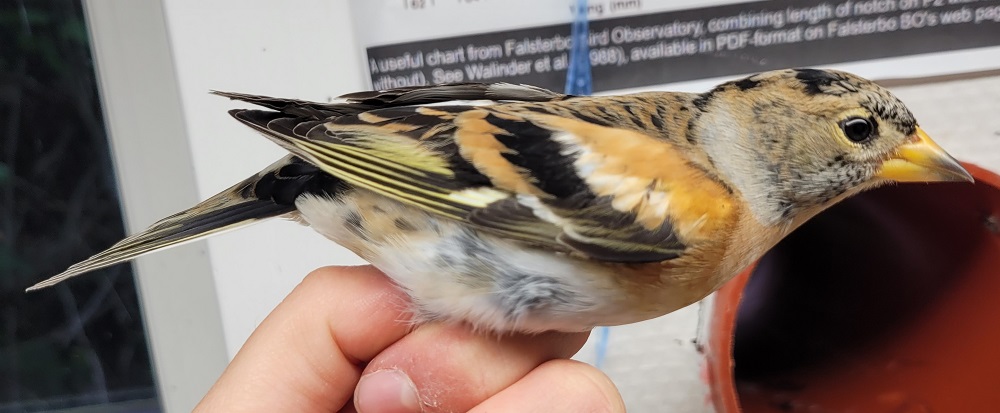
Kvækerfinke
Tørvejr havde vi hele dagen, men ved middagstid ebbede det hele som sædvanlig ud og der blev lukket af for dag.
Men lur mig, om ikke Freya forsøger at gentage succesen fra i går med lidt natfangst.
Giver det pote, kommer der her en update i aften en gang.
Dagens fangster:
Trækket på Odden: En onsdag med masser af efterårstræk på sydspidsen af Danmark. Vinden var hård fra nordøst, og der kom en enkelt byge på denne 2. oktober 2024, men masser af fugle holdt kursen støt.
På havtrækket ud af Østersøen talte holdet af træktællere fra Gedser Fuglestation 4.977 Ederfugle (Somateria mollissima) i løbet af fem morgentimer. Fra land var det store tranedag med 3.660 Traner (Grus grus) på vej sydover. Værd at bemærke var også 162 Røde Glenter (Milvus milvus) samt dette efterårs første Fjeldvåger (Buteo lagopus). Dem så vi 12 af.
Nye arter i dette efterårstræk var også en Tundrasædgås (Anser serrirostris) med et gulorange bånd rundt om næbbet. Dem skal der nok komme flere af.
Mere når vi ikke at skrive om onsdagstrækket på grund af en personalemiddag. Vi er tilbage på posten torsdag morgen.
Folk på stationen: Vagn Lind, Freya Mørup-Petersen, Lara Winsloe, Larissa Britton, Mads Elley, Ole Friis Larsen. Fra onsdag aften også Lars Ulrik Rasmussen
Regn med kjover
Ringmærkningen: The month of October has arrived and, with it, new experiences. Today, I ringed my first Song Thrushes/Sangdrossel (Turdus philomelos). It is a childhood dream of mine to see birds up-close, within my hands. I admired the thrush’s beautiful chest markings, which are reminiscent of upside-down hearts. This was the largest bird I have handled so far, and I was appreciative for this practice. The bird was well-behaved and sat well in-hand – I was thankful for its patience with me. Similarly, I am very grateful to Vagn and Freya for their patience and sharing of ringing wisdom. Tak!
Despite the few birds today, we had a surprising catch: a Common Reed Warbler/Rørsanger (Acrocephalus scirpaceus), late for the season. Freya ringed this bird. Personally, I had never seen a Reed Warbler this close, as I am more familiar to its rhythmic singing from within the reed beds. Later in the morning it started to rain, and the wind picked up, so we closed the nets and retreated inside to dry off and have some te og kaffe.
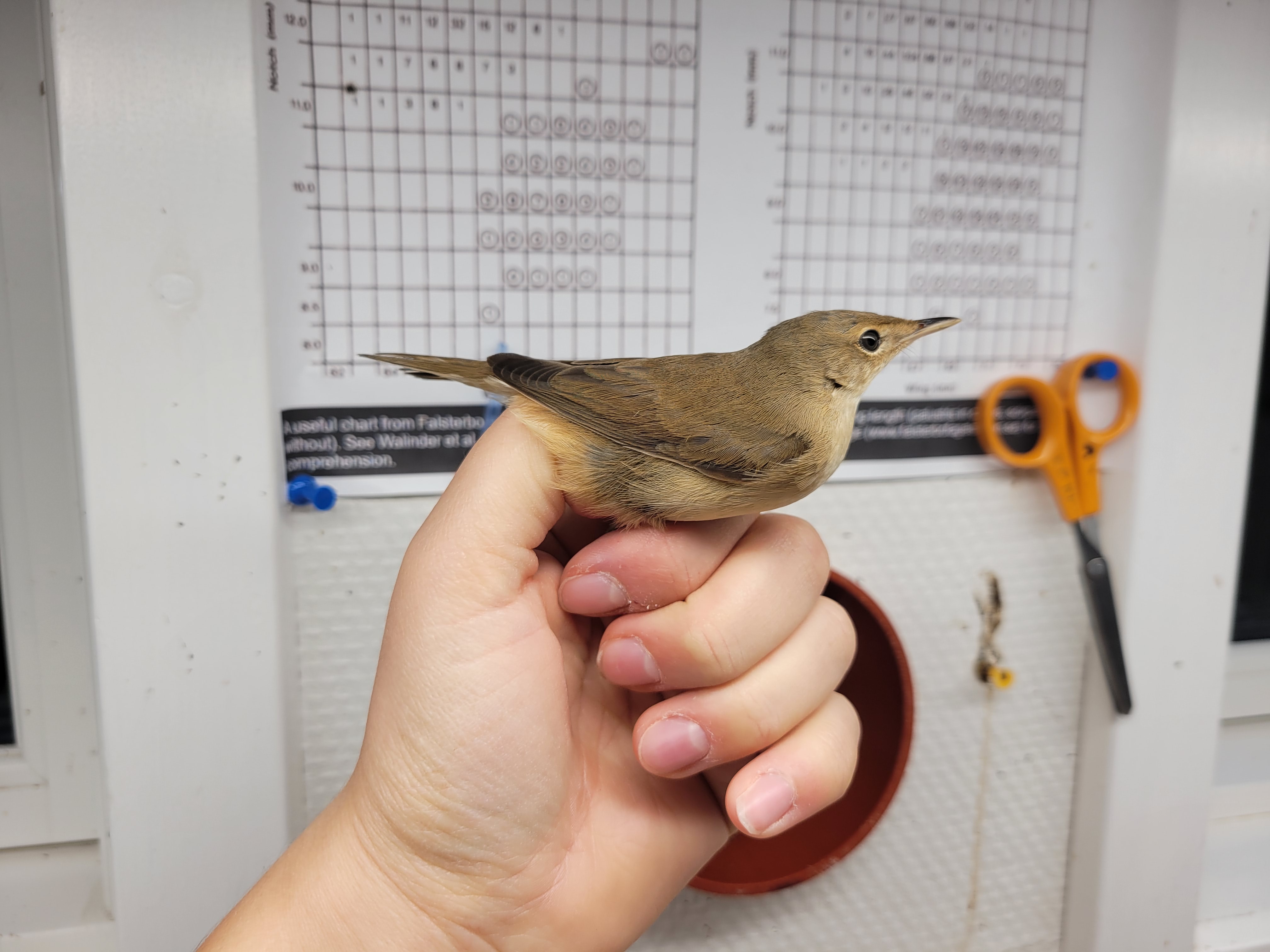
Common Reed Warbler/Rørsanger (Acrocephalus scirpaceus) in hand. Very pretty. Foto: Freya Mørup-Petersen
Opdatering: Jeg gik ud i nattens mulm, regn og mørke med natkikkert lygte og ketcher og fangede en Engpiber og to Sanglærker. Da jeg kom tilbage var de andre ved at krybe til køjs, men Lara og Larissa kom med op til laboratoriet. Lara mærkede den ene lærke, da det var en ny art i hånden for hende og jeg tog de to andre fugle. Bestemt en vellykket natfangst!

To Sanglærker med vidt forskellige mål. Den til venstre havde væsentlig mere fedt end den til højre og vejede også 6 gram mere - forskellen ses tydeligt.
Trækket på Odden: Hård vind fra øst pressede fuglene tættere på land, og vi oplevede et forrygende havtræk, hvor det mest interessante var, om vi også ville se fugle, når regnen kom. Vi kunne se på radarbilledet fra meteorologisk institut, at et stort område nærmede sig sydfra, og vi kom til at stå i tørvejr under halvtaget på den gamle marinestation i halvdelen af de fem timers standardtid. En stor del af oplevelsen blev derfor, at regnen tilsyneladende intet betød for ænder, måger og andre havfugle, men vi stort set intet træk oplevede fra land med det blæsende, våde vejr. Tre Traner (Grus grus) landede på marken, fem Røde Glenter (Milvus milvus) vendte om, og vi så næsten ingen småfugle.
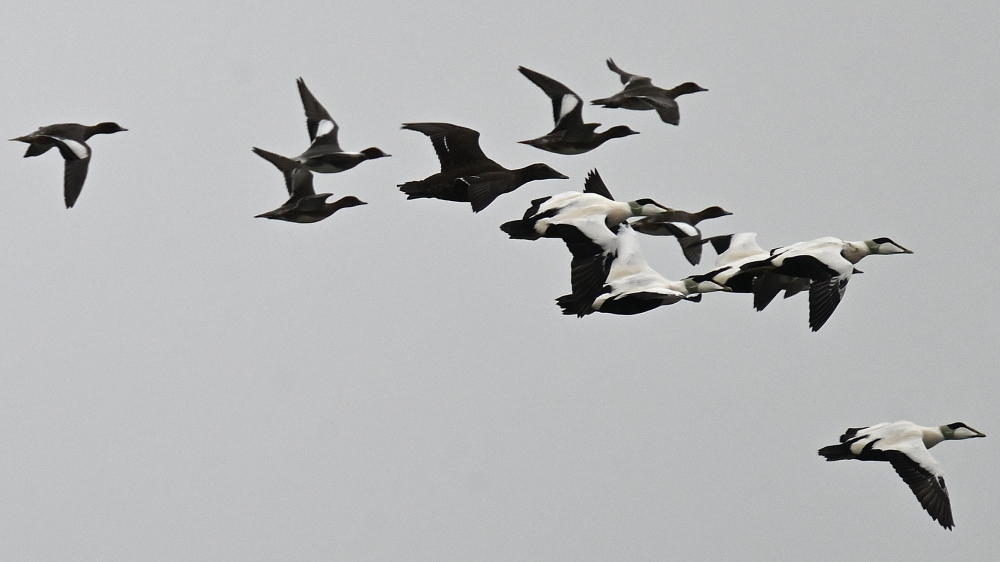
Den første time omkring solopgang talte vi cirka tusind fugle på træk i tærvejr over havet, og sådan blev det stort set ved resten af formiddagen. Det samlede resultat på de fem timer blev 4.865 fugle af 35 arter med lige under 3.000 Ederfugle (Somateria mollissima) som dagens topscorer i antal fulgt af et pænt antal Pibeænder (Mareca penelope) på næsten 900 og lidt over 100 Krikænder (Anas crecca).
Med til fornøjelsen hørte en voksen/adult han Blå Kærhøg (Circus cyaneus), som uden at tøve trak ud over vandet, og så var der pludselig 7 kjover i samlet flok. Det var fantastisk.
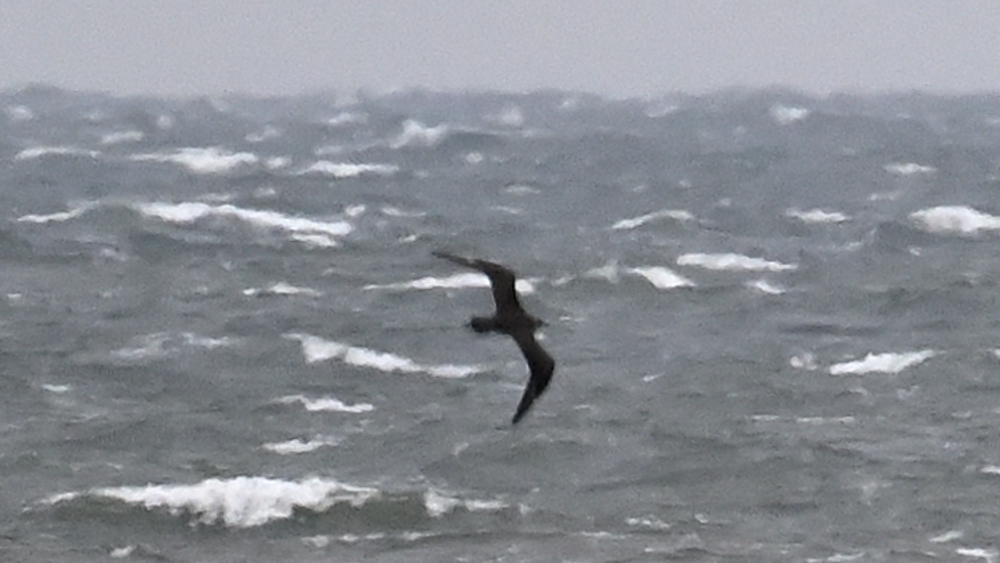
Seks af dem var Almindelige Kjover (Stercorarius parasiticus), slanke, elegante og mørke med lyse felter på vingerne i gråvejret, og en af dem var en tydeligt mindre Lille Kjove (Stercorarius longicaudus). Den var lysere og havde anderledes lyse felter på oversiden af vingerne den de Almindelige Kjover, som nok er dem, vi ser flest af, men ikke er så almindelige endda ved Gedser Odde. Hos Lille Kjove dannes de lyse felter på oversiden af vingerne af hvide skafter på de yderste primærer (de ydre lange fjer på vingerne), og vi så dem som langstrakte smalle lyse felter yderst på oversiden af vingerne.
Se alle dagens observationer fra Gedser Odde i DOFbasen.
People at the observatory: Vagn Lind, Hans Lind, Lara Winsloe, Larissa Britton, Freya Mørup-Petersen, Tina & Mads Elley, Ole Friis Larsen
Finkernes store dag
Ringmærkningen: Dagen startede med en god sjat Rødhalse og Gransangere og vi var fire ringmærkere, Vagn, Hans, Larissa og jeg. Larissa er kommet fra England for at ringmærke hele efterårssæsonen og i dag var hendes første dag med ringmærkning. Efter de første to runder var overstået, overtog Larissa ringmærkningen ved den ene mærkningsstation med lidt hjælp fra Vagn, imens jeg stod for den anden.
Larissa ringmærker sin første fugl i form af en 2k+ Rødhals, som markerer starten på hendes rejse som ringmærker. Foto: Mads Elley
En ting, der tydeligt markerede dagen, var de mange finker, der fløj over os, især Bogfinker, men også lidt Kvækerfinker i de tidlige timer. Af og til kom der nærmest 'tæpper' af finker over haven og vi tænkte, at de på Odden nok havde en travl ops med at tælle disse. Dog var der påfaldende få finker, der gik i nettene og i alt fangede vi 9 Bogfinker. Jeg forsatte lidt efter standard med få net, men lukkede klokken 15, da det blæste meget op.
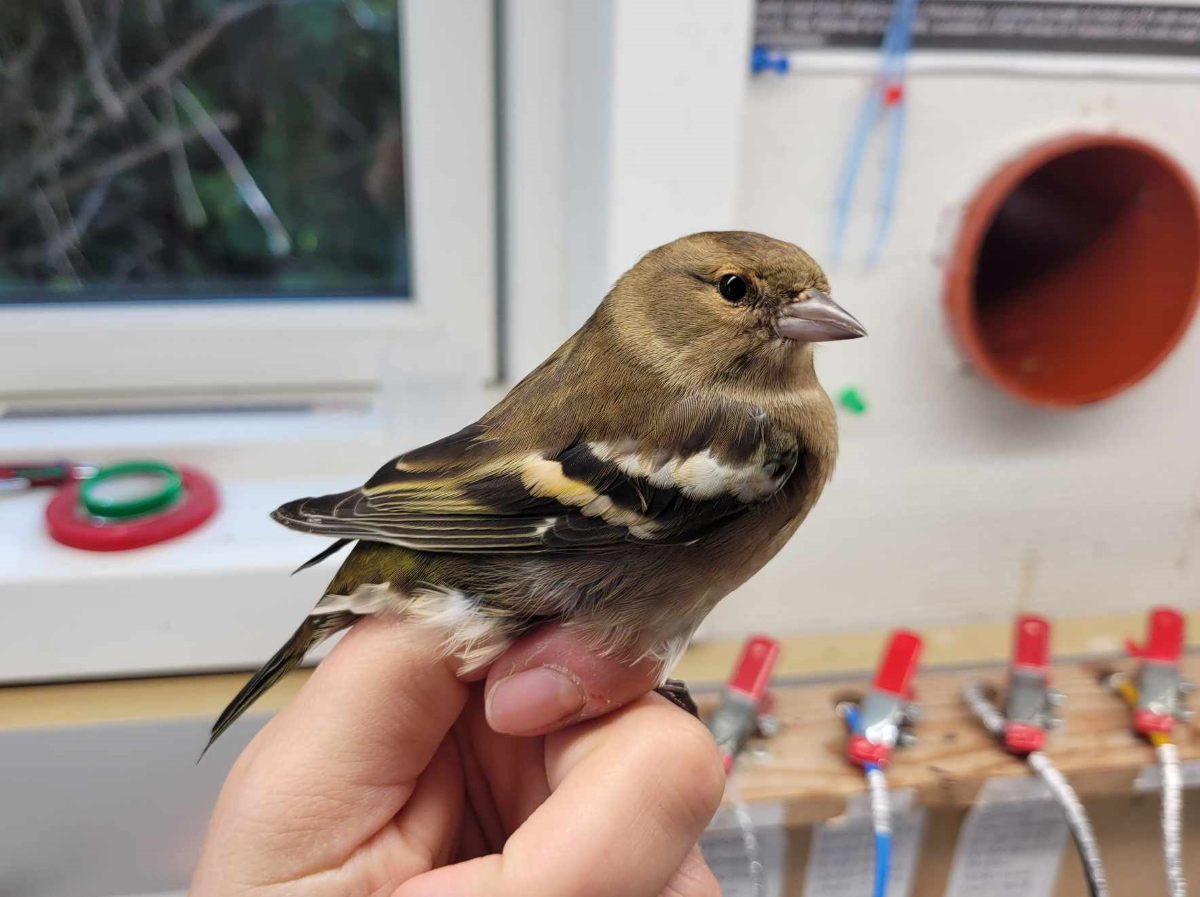
Bogfinke 1k hun. Foto: Freya Mørup-Petersen
Det var dog en flot dag i dag og vi kunne allerede fra morgenstunden se solen på en næsten skyfri himmel med en tydelig solhalo.
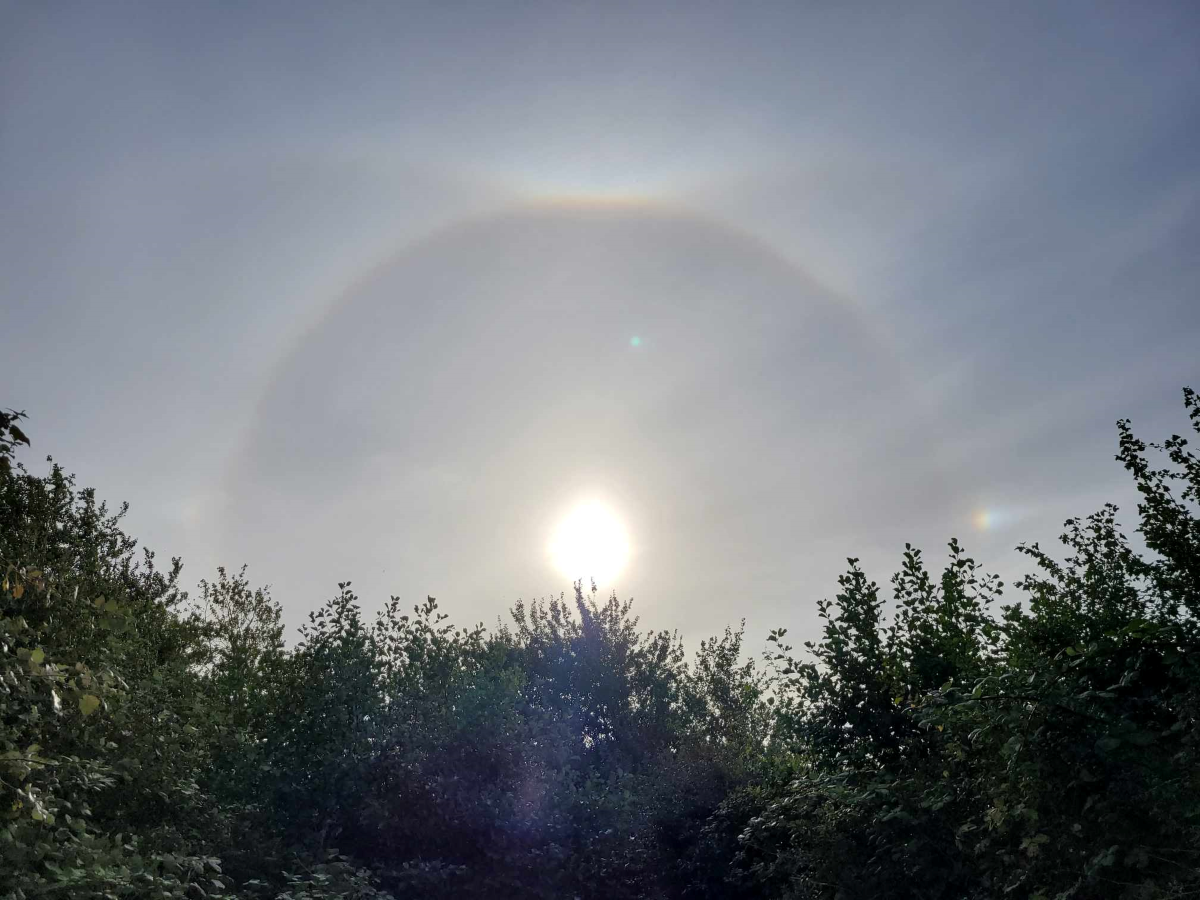
Solhalo. Foto: Freya Mørup-Petersen
Lidt om tal: Mandag bød på et spektakulært og stort træk af Bogfinker (Fingilla coelebs) og andre småfugle på Odden. Det ville vi gerne markere og fik noteret 11.156 udtrækkende Bogfinker, og det illustrerer selvfølgelig, at der foregik et stort træk af småfugle, selv om tallet ikke dækker det egentlige træk, som var meget større. Når vi tæller fugle på træk for fuglestationen går vi ud med den opgave, at vi først og fremmest skal dække trækket af ænder og andre havfugle, som kommer i så store antal, at vi kan lave statistikker over deres træk og sammenligne tallene fra år til år. Dernæst skal vi dække trækket af rovfugle og andre store fugle fra land – traner, storke, gæs. Småfuglene kommer først ind som tredje og sidste prioritet.
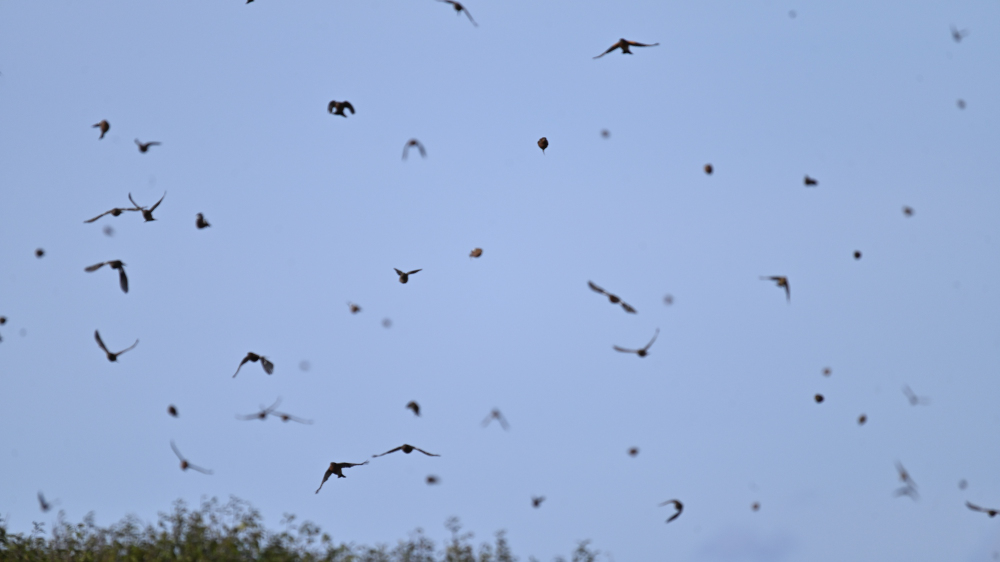
Ofte er der ikke folk nok til at dække det hele, og så bliver småfuglene valgt fra. Vi anser vores ringmærkning af småfugle for fuglestationens dækning af det træk. Mange småfugle flyver desuden så højt, at vi ikke kan se dem eller kun kan registrere dem, når der er folk på Odden med særlig god hørelse og godt kendskab til småfuglenes kald.
Mandag kom Bogfinkerne og de andre småfugle lavt, fordi de havde modvind. Det er med vind som med vand i floder – styrken er mindst tæt på land eller lavt over jorden; derfor flyver fuglene lavt i modvind og bliver meget synlige. Derfor var mandag et eksempel på det enorme træk af småfugle, der foregår lige for tiden, men mest er usynligt for os.
Vi var folk nok til at eksperimentere lidt, så en af os prøvede at lave en punkttælling af trækket af Bogfinker så neutralt som muligt ved at tælle i fem minutter af gangen tre gange i løbet af en time på minuttal, der blev fastsat i forvejen, men alarm på mobilen og med en kliktæller uden at kigge på den undervejs. Alt dette for at eliminere en trang til at tælle, når der kom flest eller til at nå et bestemt antal. Resultatet var, at der i løbet af den time kom 12.600 Bogfinker.
Vi har ikke rettet på de 11.156, som vi talte ind imellem det øvrige tællearbejde, fordi vi heller ikke havde et starttidspunkt for finketrækket. Foregik det store ryk i 2 timer og 43 minutter, eller var det 3 timer og 17 minutter? Derfor kan vi ikke gange de 12.600 op og få et mere præcist træk for dagens finketræk, men vi kan bruge eksemplet til at illustrere, at vi så et stort træk, som helt sikkert også var langt større, end vi havde forberedt os på.
Migration...continued, by Lara W
Today’s observation brought some truly astonishing numbers of birds across Gedser Odde. A total of 17, 139 birds of 35 species were counted today. A remarkable 11, 156 Chaffinch/Bogfinke (Fringilla coelebs) swirled around us in droves, often passing within a few feet of us, before plunging over the cliffs to the sea. The steady stream of little reddish-brown birds was periodically swelled by vast numbers arising from the field behind the point – it seemed many individuals rested for a short while on the ground before abruptly taking off to flow in a tidal wave over the cliff. I do not exaggerate the feeling of elation that came with not simply witnessing, but almost being a part of, this astounding natural process. Other passerines were also spotted migrating, although not nearly in so high a number, including 62 Siskin/Grønsisken (Spinus spinus), 35 Greenfinch/Grønirisk (Chloris chloris), 27 Linnet/Tornirisk (Linaria cannabina) and 16 Goldfinch/Stillits (Carduelis carduelis).
Meanwhile, out to sea, large flocks of seabirds passed by almost as continuously as the passerines. These include 2185 Wigeon/Pibeand (Anas Penelope), 1962 Common Eider/Ederfugl (Somateria mollissima), 623 Common scoter/Sortand (Melanitta nigra), 465 Teal/Krikand (Anas crecca), 163 Pintail/Spidsand (Anas acuta) and 89 Dark-bellied Brent goose/ Knortegås (Branta bernicla). The point was quite windy all morning, and we often had to shout out the counts to each other quite loudly to be heard; watching the bird flocks zip by it almost seemed they were on fast-forward. It was certainly an exercise in counting fast! We also spotted a number of gulls and terns migrating, including 82 Sandwich tern/Splitterne (Thalasseus sandvicensis), 5 Common gull/Stormmåge (Larus canus), 2 Common tern/Fjordterne (Sterna hirundo), and 8 Black-headed gull/Hættemåge. It was almost a relief that not many raptors chose to migrate this morning, although we were treated to a beautiful Montagu’s Harrier/Hedehøg (Circus pygargus), which glided about the field long enough for us to take a few photos.
A quick note about yesterday: please accept my apologies for overlooking the writing of the blog! Migration numbers totalled 2,048 individuals of 39 species. Noteworthy birds are 184 Dark-bellied Brent goose/ Knortegås (Branta bernicla), 221 Cormorant/Skarv (Phalacrocorax carbo), 109 Siskin/Grønsisken (Spinus spinus) (although 22 went north, not south!), and 350 Meadow pipit/Engpiber (Anthus pratensis). I feel a little daft writing this as these birds are ubiquitous in my homeland, but I feel I should mention that a Magpie/Husskade (Pica pica) was seen flitting about the field, which apparently is rather uncommon in this region. A Montagu’s Harrier/Hedehøg (Circus pygargus), (ID confirmed today, as the individual displayed a number of Pallid harrier/Steppehøg features) came very close, and actually landed in the field after hunting a Hare.
I stayed on at the point for a few hours after the standard count time, witnessing several large flocks of Crane/Trane (Grus grus) flying overhead, uttering their delightful trilling croaky calls. Thanks to LAH for actually birding, whilst I read a book in the sunshine. We were extremely lucky to have not one but TWO Red-footed falcon/Aftenfalk (Falco vespertinus), flying about the field by the point and actually later, visiting the station garden, where a number of the staff were able to see them. Cheers for the tip-off LAH!
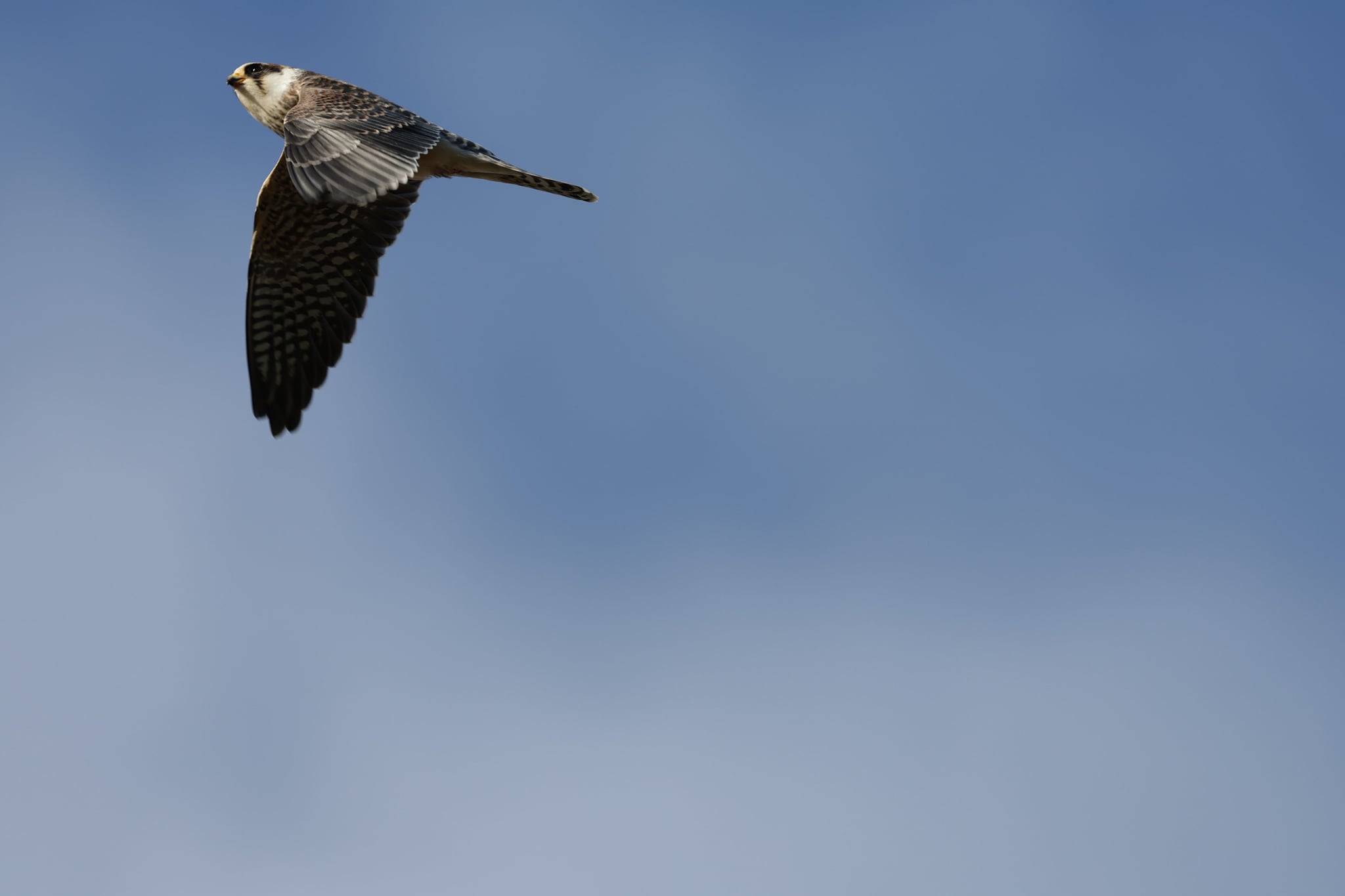
Red-footed falcon. Photo credit: LAH
Se alle dagens observationer fra Gedser Odde i DOFbasen.
People at the observatory: Vagn Lind, Hans Lind, Lara Winsloe, Larissa Britton, Freya Mørup-Petersen, Tina & Mads Elley, Ole Friis Larsen
Ringmærkerkursus dag 2
Søndag eftermiddag blev Ringmærkerforeningens og Ringmærkningsadministrationens introkursus for nye ringmærkere afsluttet på Gedser fuglestation efter 2 meget vellykkede og velorganiserede dage.
Tak til arrangører og kursister for et hyggeligt og givende arrangement. Vi var på stationen i sidste uge bekymrede for vejrudsigten, som så alt andet end lovende ud for weekenden, men det blev gjort totalt til skamme med 2 gode fangstdage i fineste vejr.
Vi håber, at alle kursister vendte hjem med lyst og inspiration til at arbejde videre med tanken om at blive aktive ringmærkere på landets fuglestationer og andre ringmærkningsprojekter.
Billeder blev der ganske enkelt alt for lidt af i kampens hede i dag,så dem må I undvære. Undskyld
Dagens fangst
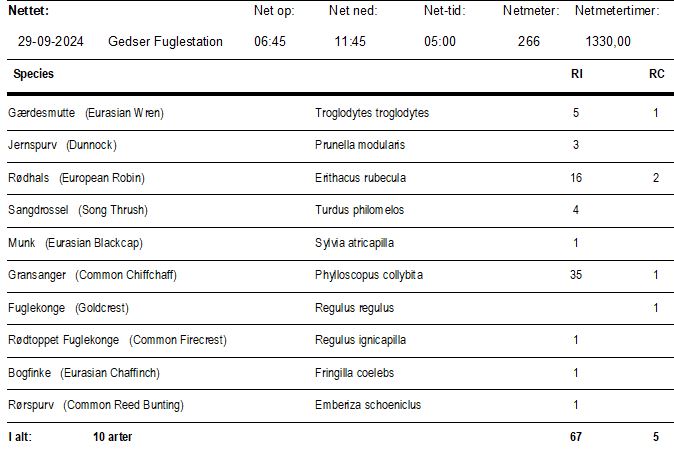
På stationen til aften: Vagn Lind, Lara Winsloe, Larissa Britton, Freya Mørup-Petersen, Ole Friis Larsen
